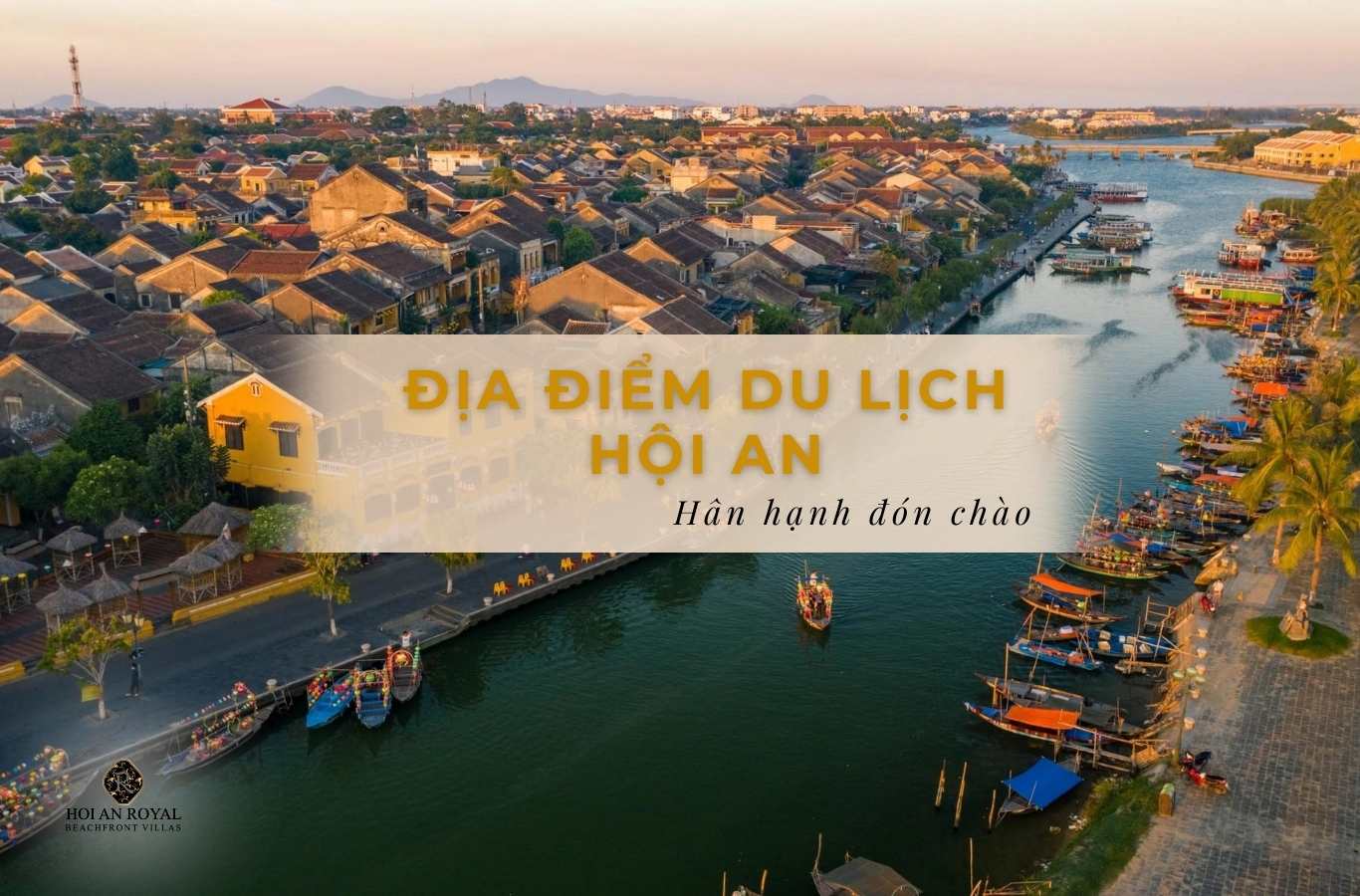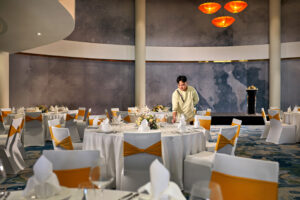Bạn sắp có chuyến đi đến phố cổ và muốn biết địa điểm du lịch Hội An nào thực sự đáng để ghé thăm? Từ những con hẻm rêu phong đến bãi biển nên thơ, Hội An là kho tàng văn hóa và cảnh đẹp chờ bạn khám phá. Trong bài viết này, Hoi An Royal Beachfront Villas sẽ giúp bạn lên danh sách những nơi đáng để ghé thăm nhất!
Mục lục
ToggleVì sao Hội An là điểm đến du lịch hàng đầu Việt Nam?
Nếu bạn đang tìm một nơi vừa đẹp, vừa yên bình lại đậm đà bản sắc, Hội An chính là câu trả lời. Nằm khiêm nhường bên dòng sông Hoài, thành phố này mang trong mình sự hòa quyện tuyệt vời giữa quá khứ và hiện tại, giữa nhịp sống cổ xưa và sự thân thiện hiện đại.
Hội An sở hữu vị trí lý tưởng khi nằm giữa hai thành phố du lịch nổi tiếng là Huế và Đà Nẵng. Nhờ kết nối thuận tiện, nơi đây dễ dàng trở thành điểm dừng chân trong các hành trình khám phá miền Trung. Từ sân bay hay nhà ga, chỉ mất khoảng 40 phút là bạn đã đặt chân đến phố cổ.
Điều làm nên linh hồn của địa điểm du lịch Hội An chính là vẻ đẹp trầm mặc của những con phố cổ. Mái ngói nâu, tường vàng rêu phong, giàn hoa giấy đung đưa trong nắng – tất cả tạo nên một không gian đậm chất Á Đông khiến người ta nhớ mãi không quên.
Không chỉ đẹp về mặt hình ảnh, Hội An còn mang đậm giá trị lịch sử và văn hóa. Từ thế kỷ 16, nơi đây từng là thương cảng sôi động, nơi các nền văn hóa giao thoa. Di tích như Chùa Cầu, nhà cổ, hội quán người Hoa là minh chứng sống động cho một thời kỳ thịnh vượng.
Với những ai yêu nhiếp ảnh hay đơn giản là thích ghi lại khoảnh khắc, Hội An là điểm đến không thể hoàn hảo hơn. Mỗi góc phố, mỗi chiếc đèn lồng, mỗi khung cửa sổ đều có thể trở thành phông nền cho những bức ảnh đẹp đến nao lòng.
Không khí yên bình tại Hội An còn được thể hiện qua những quán cà phê nhỏ ven đường. Bạn có thể ngồi hàng giờ chỉ để ngắm người qua lại, nghe vài bản nhạc xưa hoặc đơn giản là tận hưởng chút lặng yên giữa thế giới vội vã ngoài kia.
Một điểm cộng lớn khiến địa điểm du lịch Hội An ghi điểm là chi phí hợp lý. Dù bạn đi theo kiểu tiết kiệm hay nghỉ dưỡng, thành phố này đều có nhiều lựa chọn phù hợp. Dịch vụ thân thiện, chất lượng ổn và không gian dễ chịu khiến ai đến cũng hài lòng.
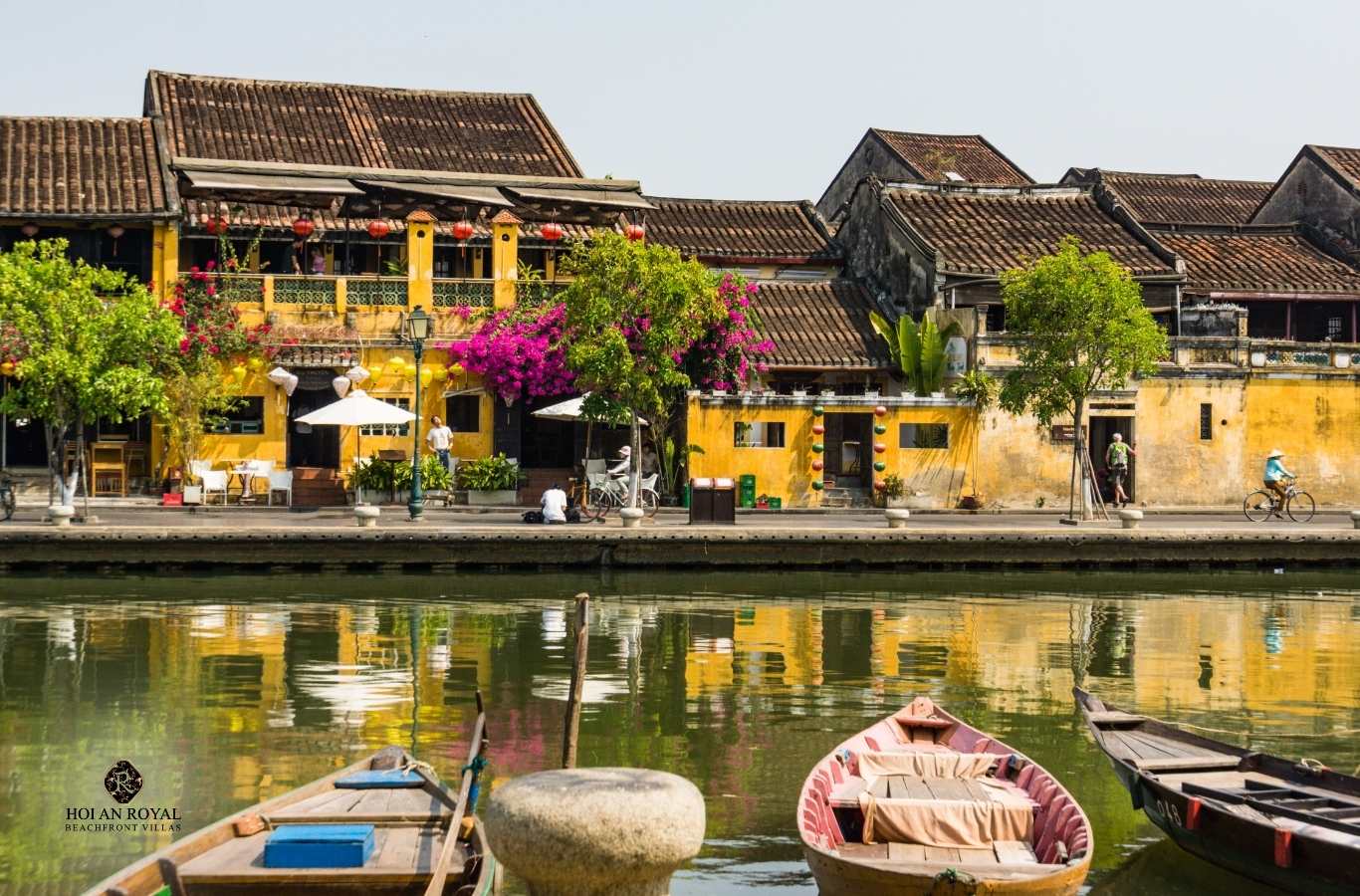
Khám phá Hội An cổ kính: Chạm vào hồn Việt giữa phố thị phồn hoa
Hội Quán Phúc Kiến
Hội quán Phúc Kiến là một trong những hội quán cổ kính nổi bật tại Hội An, được xây dựng bởi cộng đồng người Hoa gốc Phúc Kiến sinh sống tại đây. Hội quán không chỉ là nơi thờ tự, tổ chức các nghi lễ tôn giáo mà còn là công trình kiến trúc mang đậm nét văn hóa Trung Hoa.
Các chi tiết chạm khắc tinh xảo, mái ngói cong vút và các bức tranh trang trí truyền thống tạo nên vẻ đẹp đặc trưng, thu hút ánh nhìn. Đây là điểm tham quan hấp dẫn, giúp du khách hiểu thêm về sự đa dạng văn hóa và lịch sử của Hội An.
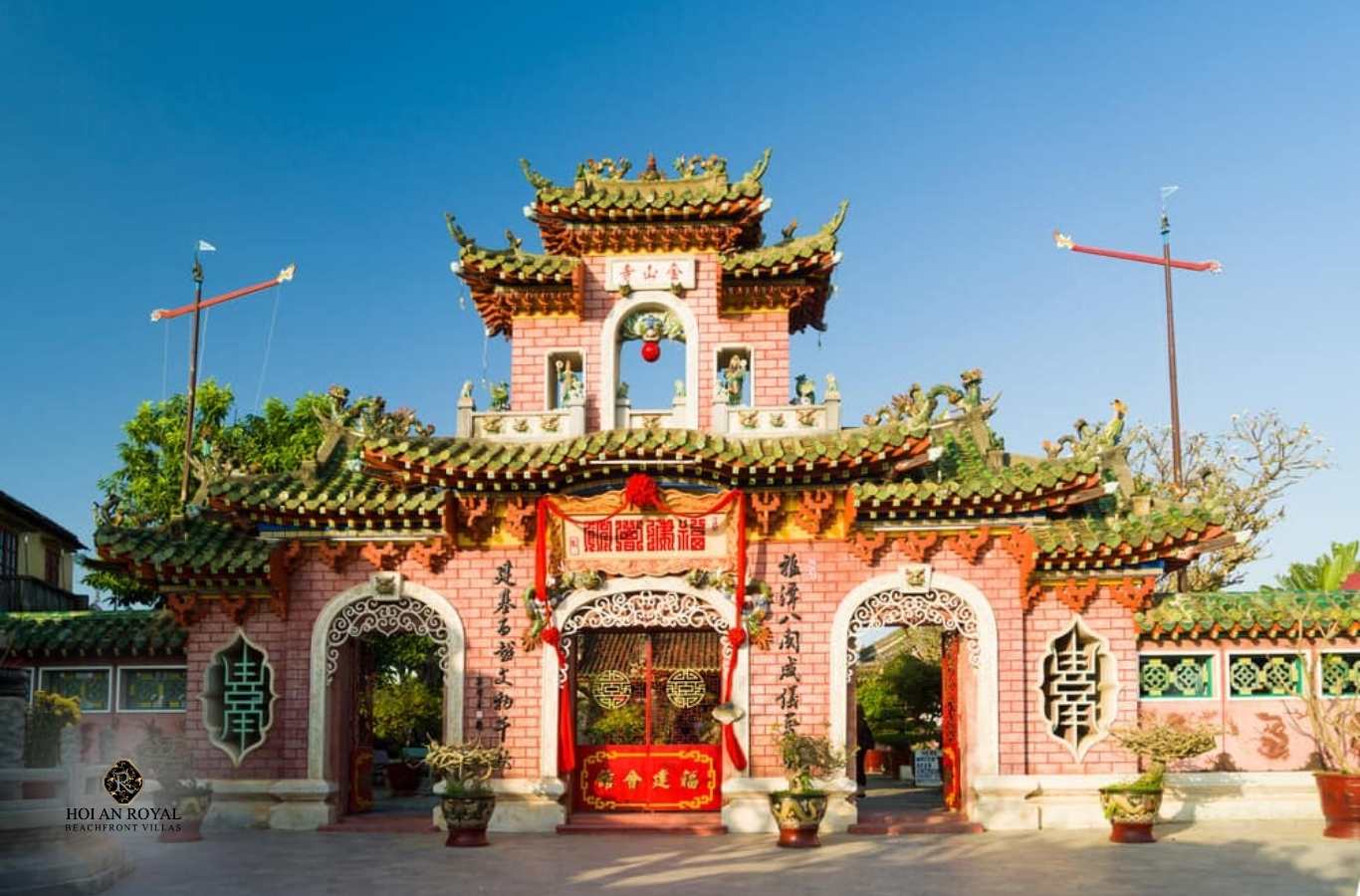
Hội quán Quảng Đông
Tương tự như Hội quán Phúc Kiến, Hội quán Quảng Đông là nơi sinh hoạt tín ngưỡng của cộng đồng người Hoa gốc Quảng Đông tại Hội An. Kiến trúc hội quán mang đậm phong cách Trung Hoa với các họa tiết trang trí cầu kỳ, tượng thờ và các bức phù điêu đặc sắc.
Hội quán là điểm đến văn hóa quan trọng, góp phần thể hiện sự đa dạng sắc tộc và truyền thống tín ngưỡng của Hội An.
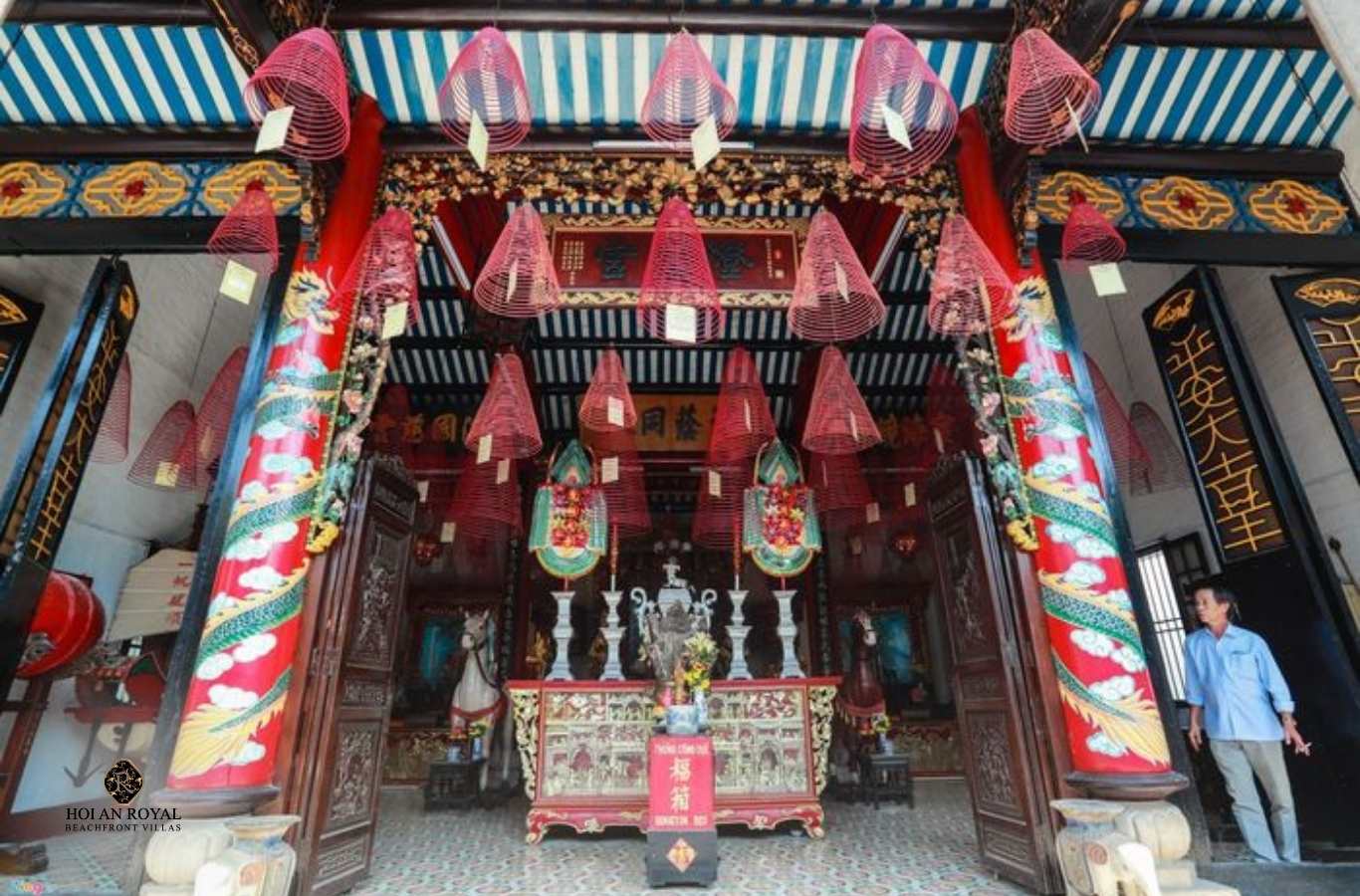
Nhà cổ Tấn Ký
Là một trong những ngôi nhà cổ nổi tiếng nhất Hội An, Tấn Kỳ không chỉ mang dấu ấn thời gian mà còn lưu giữ đầy đủ tinh thần và phong cách sống của người dân phố cổ từ hơn hai thế kỷ trước.
Ngôi nhà được xây dựng năm 1741 và là nơi sinh sống liên tục của 7 thế hệ nhà họ Lê. Không gian bên trong như một bảo tàng thu nhỏ với những vật dụng, đồ gỗ và cổ vật được bảo tồn gần như nguyên vẹn.
Kiến trúc nhà theo hình ống đặc trưng, gồm hai tầng, ba gian, vừa kín đáo vừa thoáng đãng. Đặc biệt, nhà không hề có cửa sổ mà vẫn luôn đón sáng và gió nhờ giếng trời và cách sắp đặt hợp lý. Mặt trước mở ra phố Nguyễn Thái Học để kinh doanh, mặt sau hướng ra sông Bạch Đằng – thuận lợi cho việc giao thương thời xưa.
Bên trong nhà còn lưu giữ nhiều cổ vật quý giá như chén Khổng Tử có niên đại 550–600 năm, bình gốm Chu Đậu thế kỷ XVI, các hoành phi, liễn đối… Tất cả đều phản ánh thời kỳ phồn vinh và sự giao thoa văn hóa rực rỡ của Hội An xưa.
Đến nay, tầng một của nhà cổ mở cửa đón khách tham quan, còn tầng hai vẫn là nơi sinh sống của gia chủ. Công trình được xây dựng hoàn toàn bằng kỹ thuật mộng ghép truyền thống, không dùng đến một chiếc đinh nào. Nhà cổ Tấn Kỳ đã được công nhận là di tích lịch sử văn hóa cấp quốc gia và là một phần quan trọng trong quần thể di sản thế giới UNESCO.
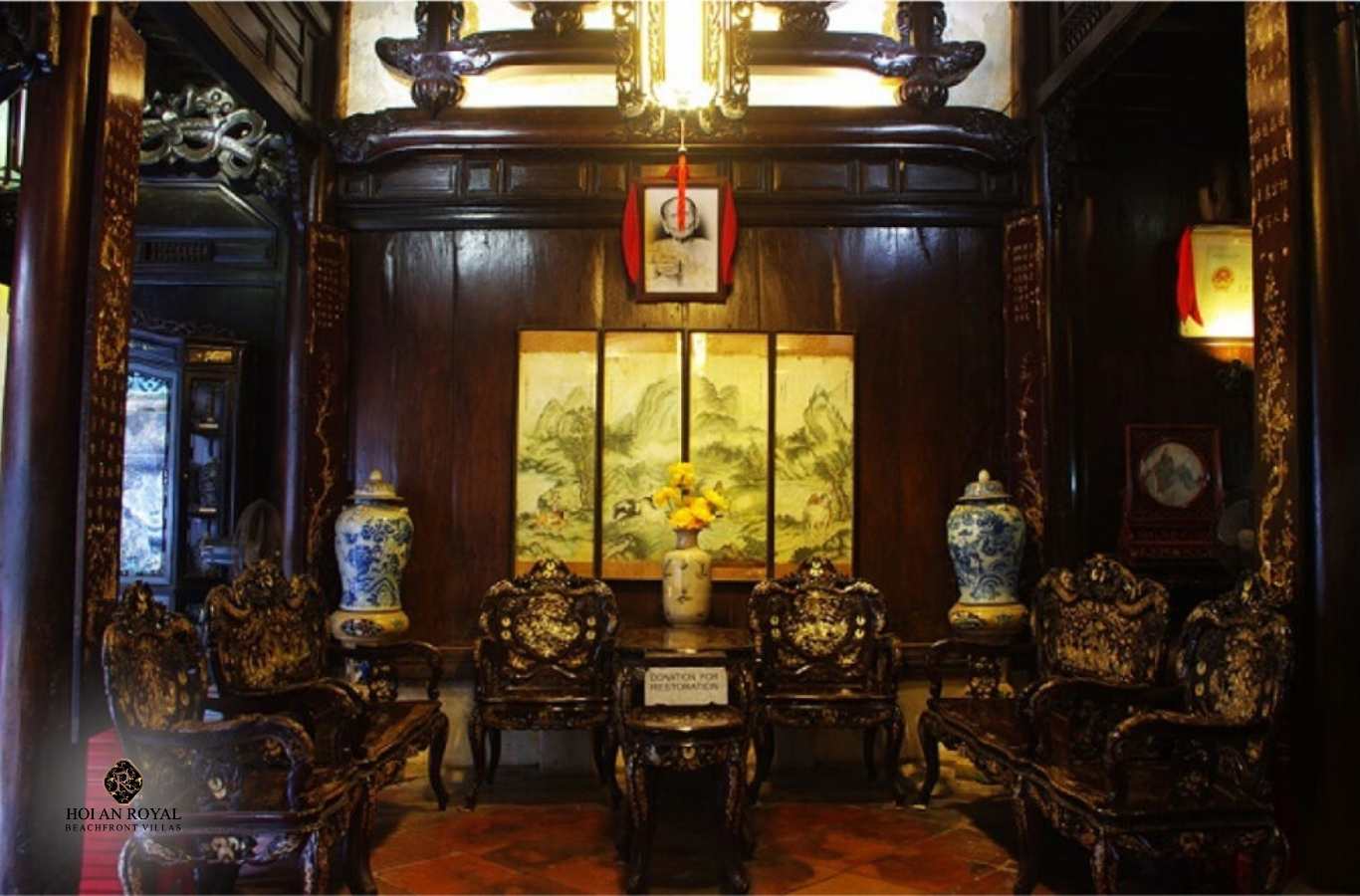
Chùa cầu Nhật Bản
Biểu tượng nổi tiếng nhất của Hội An chính là Chùa Cầu – công trình mang dáng dấp vừa lạ, vừa gần gũi, được xây dựng vào khoảng thế kỷ 16–17 bởi cộng đồng thương nhân Nhật Bản.
Cây cầu nhỏ nối liền hai con phố, với mái ngói cong mềm mại, thân cầu bằng gỗ lim vững chãi và các chi tiết chạm khắc tinh tế. Không chỉ là phương tiện đi lại, Chùa Cầu còn là nơi thờ thần bảo hộ và là điểm gắn kết tâm linh quan trọng của cư dân phố cổ.
Cây cầu là hiện thân rõ nét cho mối quan hệ Việt – Nhật thời kỳ giao thương, vừa mang giá trị kiến trúc, vừa có ý nghĩa lịch sử sâu sắc. Đó cũng là lý do Chùa Cầu luôn là điểm check-in yêu thích của mọi du khách khi đặt chân đến Hội An.
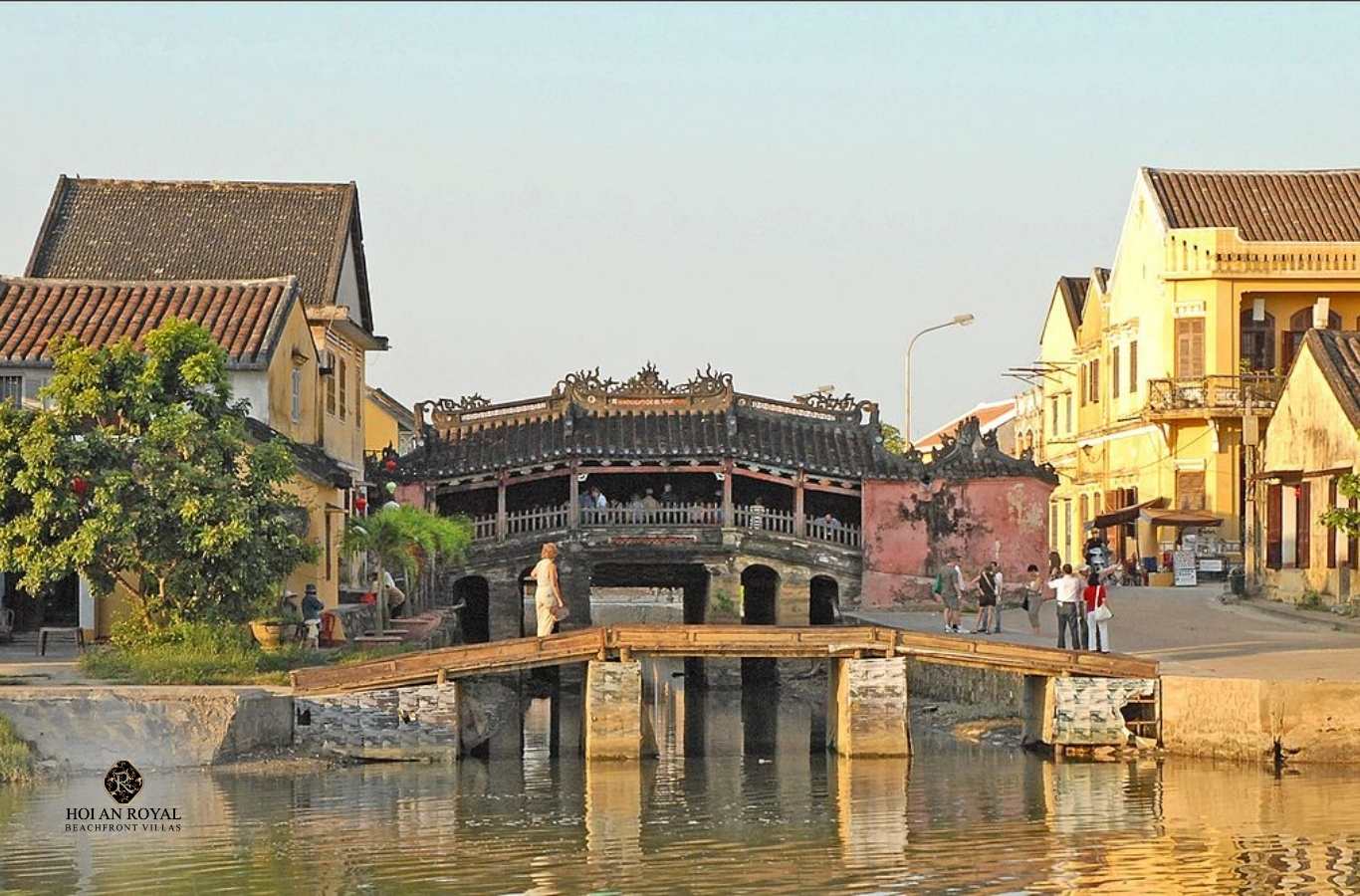
Bảo tàng văn hóa Sa Huỳnh
Bảo tàng văn hóa Sa Huỳnh mở cửa từ 7:00 – 21:00 hàng ngày, nghỉ vào ngày 10 và 25 hàng tháng để phục vụ công tác chuyên môn. Đây là điểm đến đặc biệt với những ai quan tâm đến lịch sử văn minh cổ đại của Hội An và miền Trung.
Thành lập từ năm 1994–1995, bảo tàng trưng bày hơn 900 hiện vật có niên đại khoảng 2000 năm. Các hiện vật được khai quật tại nhiều địa điểm như Hậu Xá, Thanh Chiêm, An Bàng, Xuân Lâm và Cù Lao Chàm – nơi cư dân Sa Huỳnh từng sinh sống.
Bộ sưu tập gồm:
- Đồ gốm, đồ trang sức bằng vàng, đồng, đá quý
- Công cụ lao động bằng đá, đồng, sắt
- Hiện vật phản ánh tín ngưỡng, phong tục mai táng, quan niệm thẩm mỹ
Bảo tàng sở hữu một trong những bộ sưu tập văn hóa Sa Huỳnh phong phú nhất Việt Nam, góp phần quan trọng trong công cuộc bảo tồn và nghiên cứu lịch sử cổ đại tại Hội An.
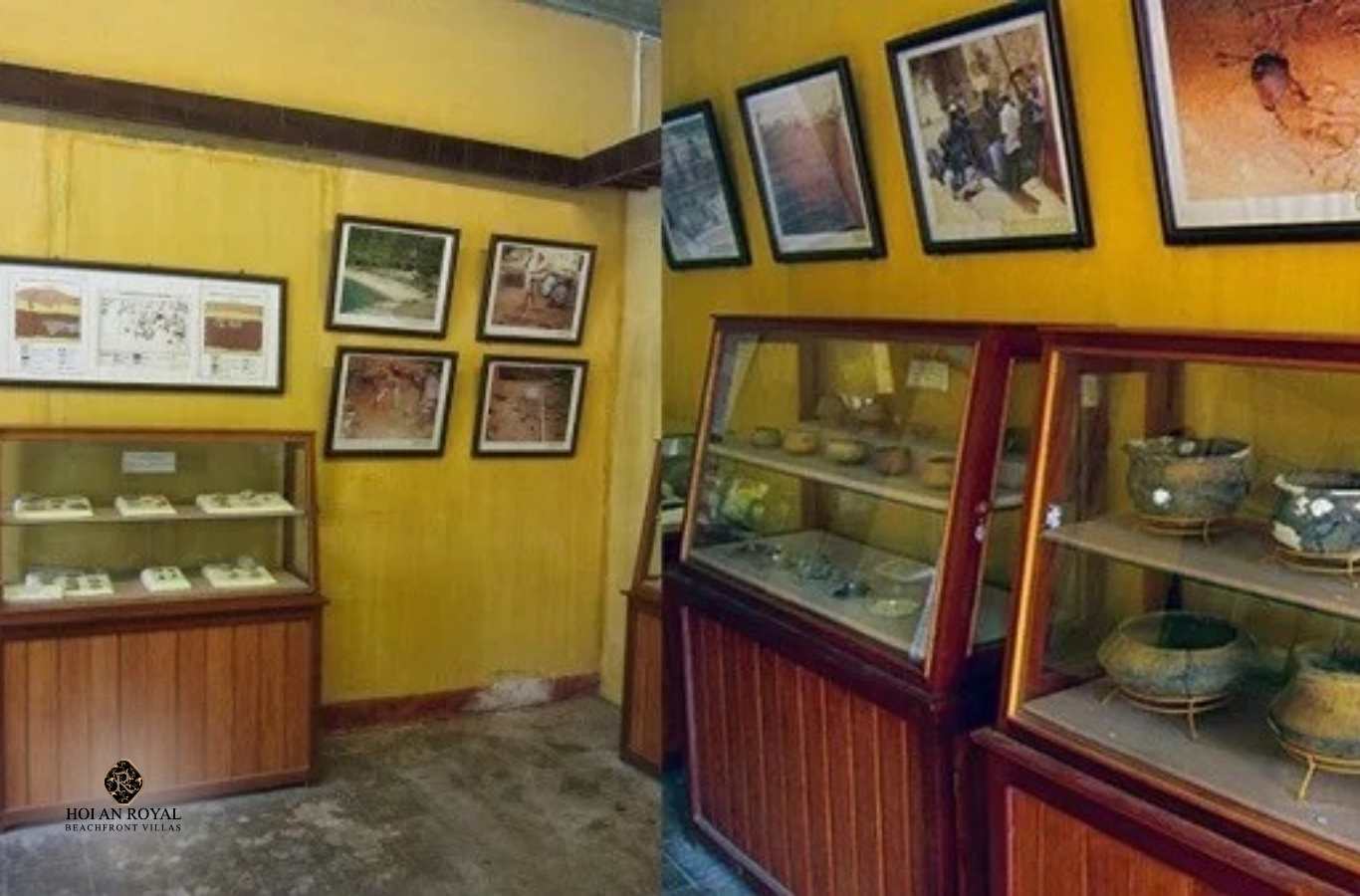
Bảo tàng gốm sứ thương mại
Bảo tàng gốm sứ thương mại là nơi lưu giữ các hiện vật liên quan đến hoạt động giao thương gốm sứ qua các thời kỳ hưng thịnh của Hội An. Đây là minh chứng sinh động cho vai trò cảng thị quốc tế sôi động bậc nhất khu vực Đông Nam Á xưa.
Tại đây, du khách có thể chiêm ngưỡng các hiện vật gốm sứ nhập khẩu từ Trung Quốc, Nhật Bản, Thái Lan và nhiều nước khác. Mỗi hiện vật đều mang theo những câu chuyện về hành trình buôn bán, trao đổi hàng hóa diễn ra sôi nổi suốt nhiều thế kỷ.
Không chỉ là điểm đến lý tưởng cho người yêu thích gốm sứ, bảo tàng còn giúp người xem hình dung rõ hơn về mạng lưới giao thương rộng lớn và vị thế đặc biệt của Hội An trong lịch sử thương mại châu Á.
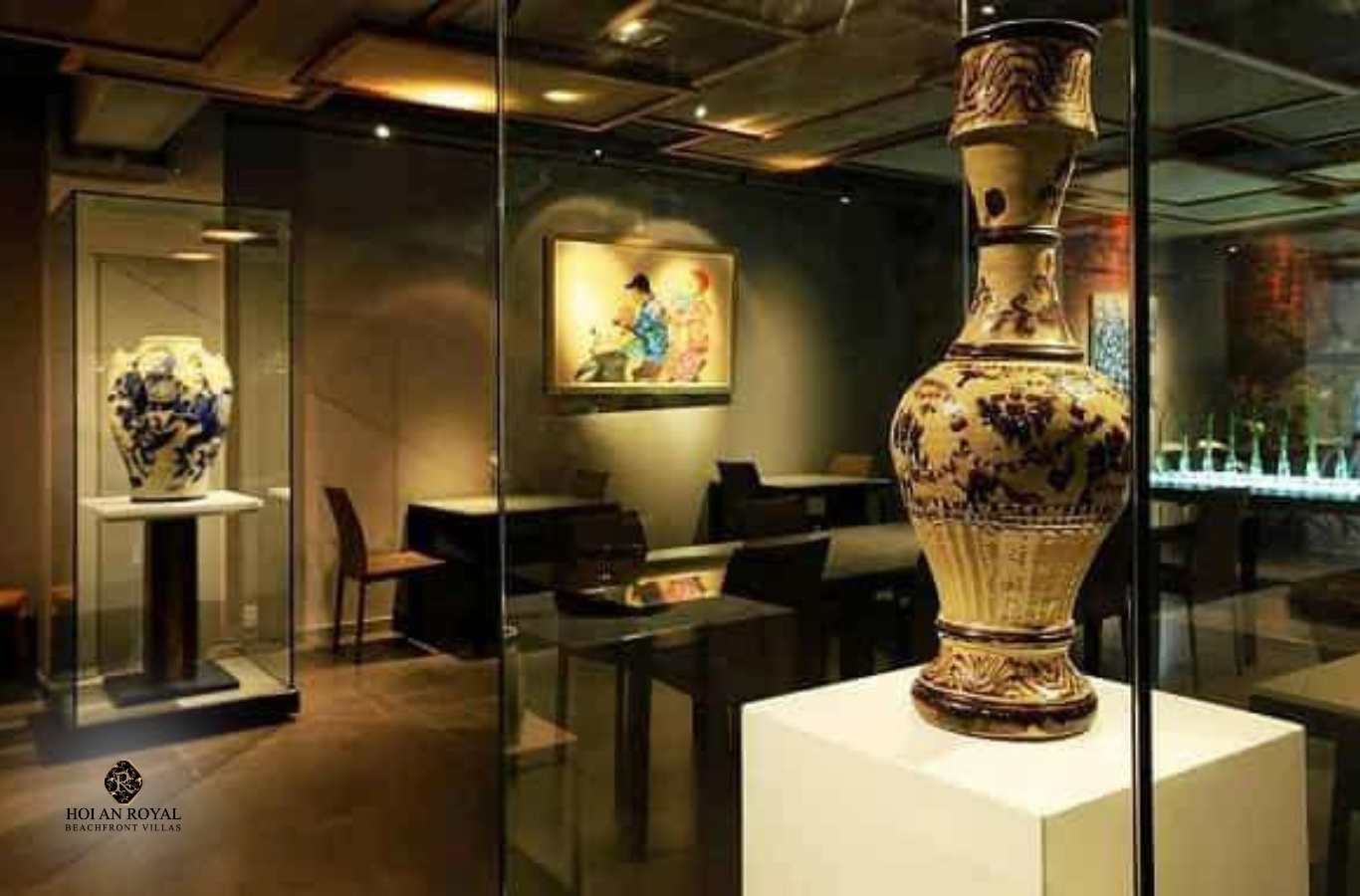
Bảo tàng Hội An
Bảo tàng Hội An là nơi lưu giữ toàn cảnh lịch sử hình thành và phát triển của thành phố, từ thương cảng quốc tế phồn vinh đến di sản văn hóa thế giới được UNESCO vinh danh.
Không gian trưng bày bao gồm các cổ vật, hình ảnh, bản đồ, hiện vật liên quan đến các ngành nghề truyền thống, lễ hội văn hóa, và những di tích gắn liền với đời sống cư dân phố cổ. Tất cả đều được sắp xếp theo dòng thời gian dễ theo dõi.
Đây là điểm dừng chân không thể bỏ qua nếu bạn muốn tìm hiểu sâu hơn về những giá trị văn hóa, kiến trúc và đời sống xã hội đã làm nên một Hội An cổ kính, bền bỉ và đặc biệt như ngày nay.
Nằm tại số 21 đường Lê Lợi, nhà thờ tộc Trần là một trong những công trình tín ngưỡng lâu đời và tiêu biểu ở Hội An. Được xây dựng từ năm 1802 bởi cụ Trần Tứ Nhạc – một vị quan thanh liêm thời vua Gia Long, nơi đây ra đời nhằm thờ cúng tổ tiên và làm chốn hội tụ của con cháu dòng họ Trần.
Nhà thờ có diện tích khoảng 1.500m², được thiết kế theo kiểu nhà vườn truyền thống. Mái ngói âm dương, hệ thống kèo cột bằng gỗ lim, các chi tiết chạm khắc tinh xảo tạo nên không gian trang nghiêm, thấm đẫm nét rêu phong cổ kính.
Công trình gồm ba gian, hai nếp nhà, một cửa chính và hai cửa phụ – trong đó cửa chính chỉ mở vào dịp lễ quan trọng. Kiến trúc hòa quyện giữa phong cách Việt, Trung Hoa và Nhật Bản, thể hiện rõ sự giao thoa văn hóa tinh tế.
Vừa mang ý nghĩa tín ngưỡng, nơi đây còn là biểu tượng cho đạo hiếu, truyền thống hướng về cội nguồn và tôn kính tổ tiên của người dân Hội An. Du khách đến tham quan sẽ cảm nhận được sự tĩnh lặng, trang trọng giữa lòng phố cổ sôi động.

Nhà cổ Đức An
Nhà cổ Đức An là một trong những ngôi nhà truyền thống tiêu biểu của Hội An, gắn liền với hình ảnh những thương nhân giàu có một thời. Nét đẹp kiến trúc và giá trị văn hóa vẫn còn được gìn giữ gần như nguyên vẹn qua từng chi tiết.
Ngôi nhà sở hữu mái ngói âm dương, tường vàng đặc trưng, các cột gỗ lim vững chãi và những chạm khắc gỗ công phu. Không gian bên trong đơn giản nhưng tinh tế, phản ánh đúng lối sống thanh lịch và thực dụng của cư dân phố cổ xưa.
Nhà cổ Đức An vừa là nơi ở vừa là một phần ký ức của Hội An. Đây là điểm dừng chân thú vị cho du khách muốn tìm hiểu rõ hơn về nếp sống, sinh hoạt và văn hóa kiến trúc bản địa đã tồn tại qua nhiều thế hệ.
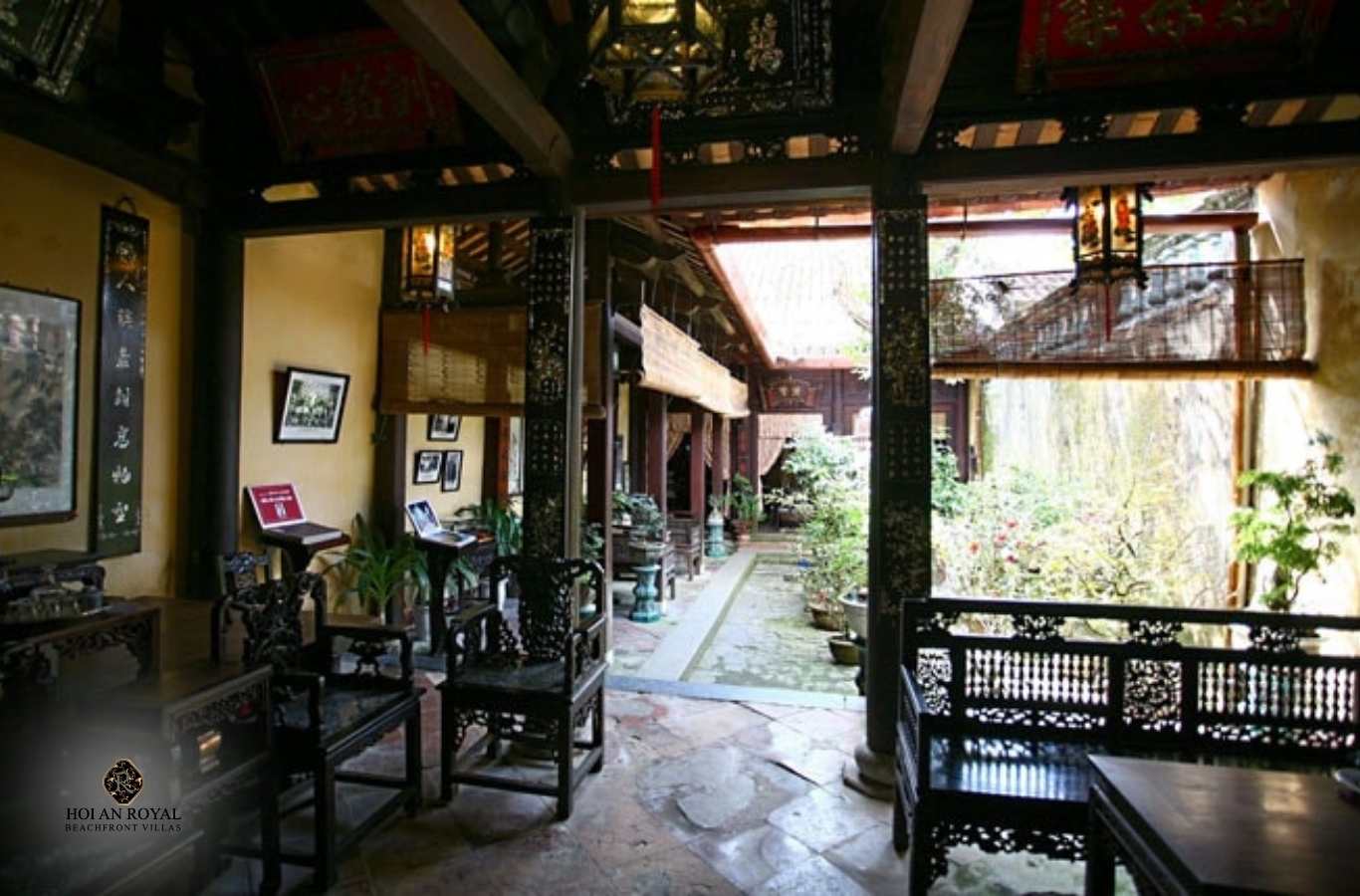
Nhà cổ Thái Phiên
Nhà cổ Thái Phiên là một trong những công trình cổ còn được bảo tồn tốt tại phố cổ Hội An. Ngôi nhà mang trong mình vẻ đẹp mộc mạc, chuẩn mực của kiến trúc nhà ống truyền thống miền Trung.
Cấu trúc nhà được xây bằng khung gỗ lim, mái ngói âm dương, tường vàng và cửa gỗ sẫm màu – tất cả đều được chạm khắc tỉ mỉ, phản ánh trình độ thủ công tinh xảo của người xưa. Không gian trong nhà chia thành nhiều lớp, tạo sự thông thoáng và thuận tiện sinh hoạt.
Đây từng là nơi ở của giới thương nhân buôn bán phát đạt, là minh chứng cho thời kỳ thịnh vượng của Hội An trong quá khứ. Nhà cổ Thái Phiên hiện mở cửa cho du khách tham quan để khám phá không gian sống truyền thống và văn hóa phố cổ.
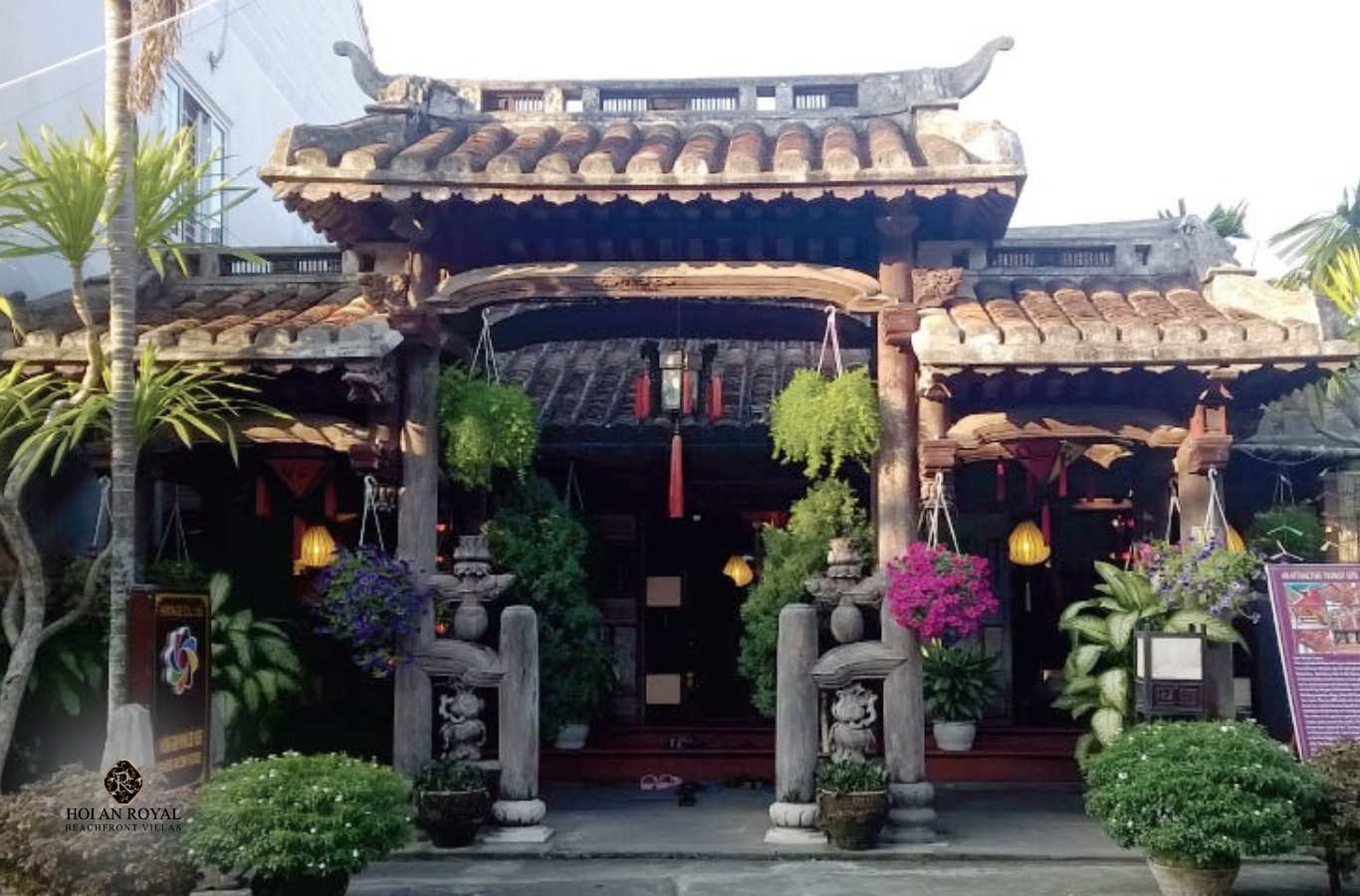
Chợ Hội An
Chợ Hội An nằm ngay trung tâm phố cổ, là nơi giao thoa sôi động giữa đời sống văn hóa và kinh tế địa phương. Với lịch sử hình thành từ thế kỷ XIX, khu chợ từng là nơi buôn bán sầm uất của cộng đồng người Hoa như Quảng Đông, Phúc Kiến, Triều Châu và Hải Nam.
Kiến trúc nhà lồng cổ kính với mái ngói rêu phong, tường vàng và hệ cột vững chắc mang đậm dấu ấn kiến trúc Pháp. Bên trong, chợ chia thành nhiều khu riêng biệt: hải sản, rau củ, trái cây, hàng khô, đồ lưu niệm và đặc biệt là khu ẩm thực phong phú.
Không chỉ là nơi mua sắm, Chợ Hội An còn là không gian lưu giữ hương vị, âm thanh và nhịp sống của người dân phố cổ. Lonely Planet từng bình chọn nơi đây là một trong sáu “thiên đường ẩm thực” hấp dẫn nhất dành cho du khách.
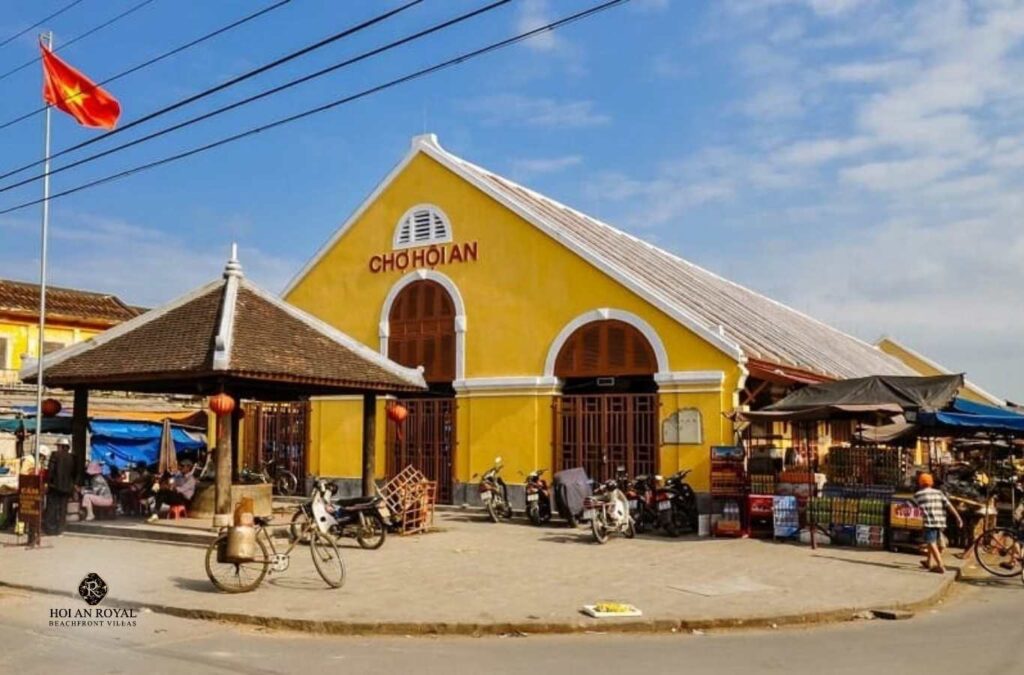
Trải nghiệm thiên nhiên và làng quê yên bình
Rừng dừa Cẩm Thanh
Nằm cách trung tâm phố cổ Hội An khoảng 3km, rừng dừa Cẩm Thanh – hay còn gọi là rừng dừa Bảy Mẫu – là khu du lịch sinh thái nổi tiếng, mang lại trải nghiệm sông nước hiếm thấy giữa miền Trung. Nơi đây rất dễ di chuyển bằng xe máy, xe đạp hoặc thuyền ghe từ phố cổ.
Rừng dừa có diện tích hơn 100 ha, bao phủ bởi hàng ngàn cây dừa nước xanh mướt và những rạch nước trong veo. Cảnh quan nơi đây mang dáng dấp của miền Tây sông nước, mát mẻ và thanh bình – chính vì thế còn được ví như “miền Tây giữa lòng phố Hội”.
Được người dân từ vùng Tây Nam Bộ di cư vào trồng khoảng 200 năm trước, rừng dừa không chỉ là lá phổi xanh của Hội An mà còn là di tích sống phản ánh sự giao thoa văn hóa và sinh kế truyền thống.
Tại đây, du khách có thể trải nghiệm chèo thuyền thúng xuyên rừng dừa, xem múa thúng, câu cá, làm đồ lưu niệm từ lá dừa và thưởng thức cơm dừa muối vừng – món ăn dân dã mang đậm hương vị địa phương.
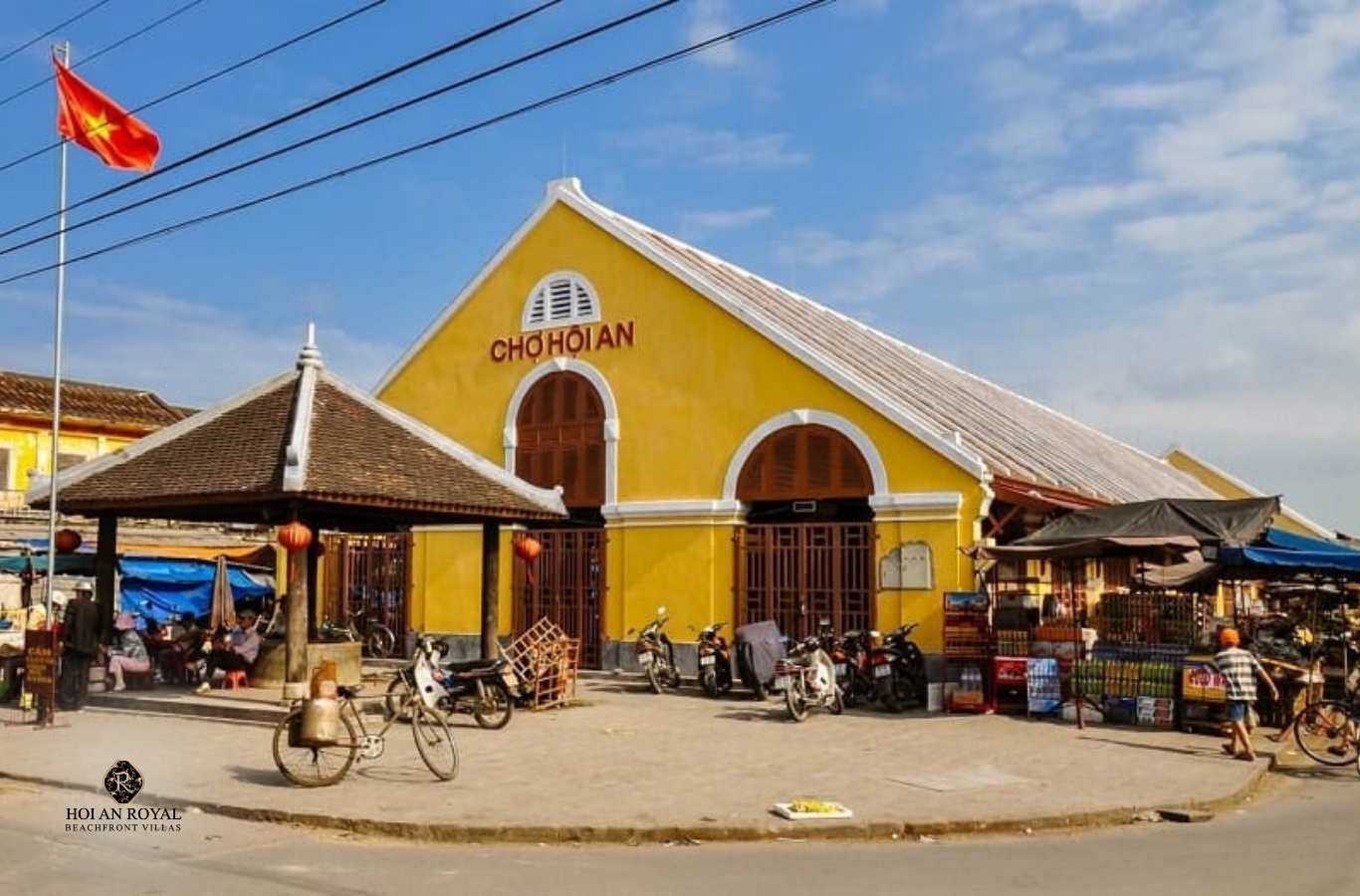
Lò Gạch Cũ
Lò gạch cũ là một điểm đến gợi nhắc về quá khứ lao động thầm lặng của người Hội An trong nghề làm gạch truyền thống. Trước đây, nơi này từng cung cấp vật liệu cho nhiều công trình kiến trúc nổi bật trong phố cổ.
Công trình tuy không còn hoạt động sản xuất nhưng vẫn giữ lại được hình dáng và cấu trúc lò gạch xưa, là dấu tích quan trọng giúp người xem hình dung lại quá trình hình thành đô thị cổ.
Khi đến tham quan, du khách có thể tìm hiểu quy trình làm gạch thủ công, quan sát các sản phẩm gạch cũ còn lưu giữ, và cảm nhận rõ nét một phần đời sống sản xuất truyền thống gắn bó với kiến trúc Hội An.
Không gian nơi đây không cầu kỳ nhưng lại mang giá trị lịch sử và văn hóa rõ rệt, góp phần làm phong phú thêm trải nghiệm về các làng nghề xưa của phố cổ.
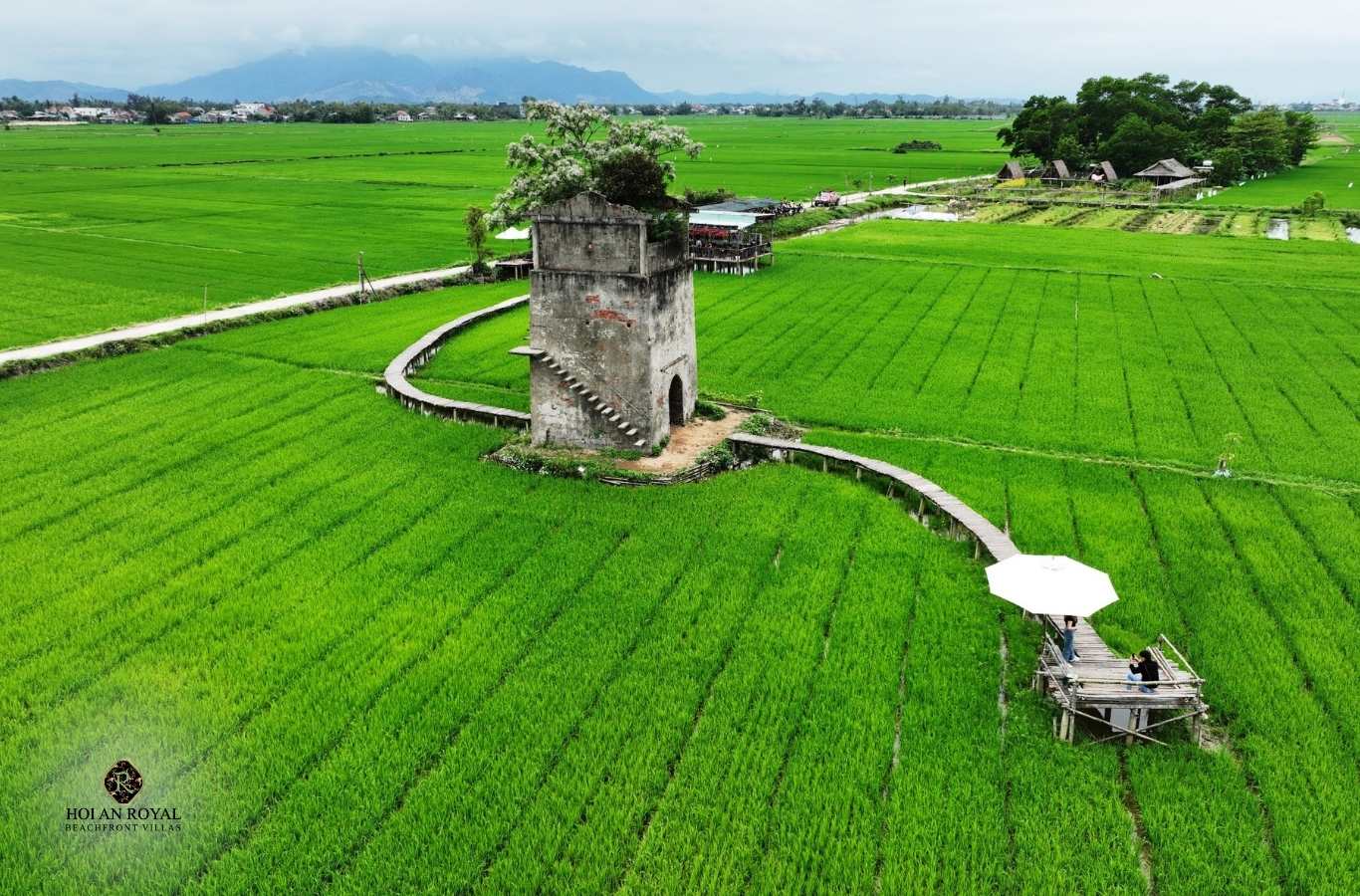
Làng rau Trà Quế
Cách trung tâm Hội An khoảng 3km, làng rau Trà Quế thuộc xã Cẩm Hà là một trong những điểm du lịch sinh thái tiêu biểu, nổi tiếng với nghề trồng rau sạch truyền thống hoàn toàn không dùng hóa chất độc hại.
Người dân ở đây vẫn giữ phương pháp canh tác hữu cơ, sử dụng rong biển và phân xanh từ sông Thu Bồn, tạo nên những luống rau xanh mướt quanh năm. Nhiều loại rau thơm Trà Quế còn được xem là linh hồn trong các món ăn đặc sản Hội An.
Du khách đến làng có thể trải nghiệm làm nông như người bản xứ: trồng rau, tưới nước, thu hoạch. Ngoài ra còn có thể tham gia các hoạt động như nấu ăn, tham quan vườn, thưởng thức món ăn chế biến từ rau tại chỗ.
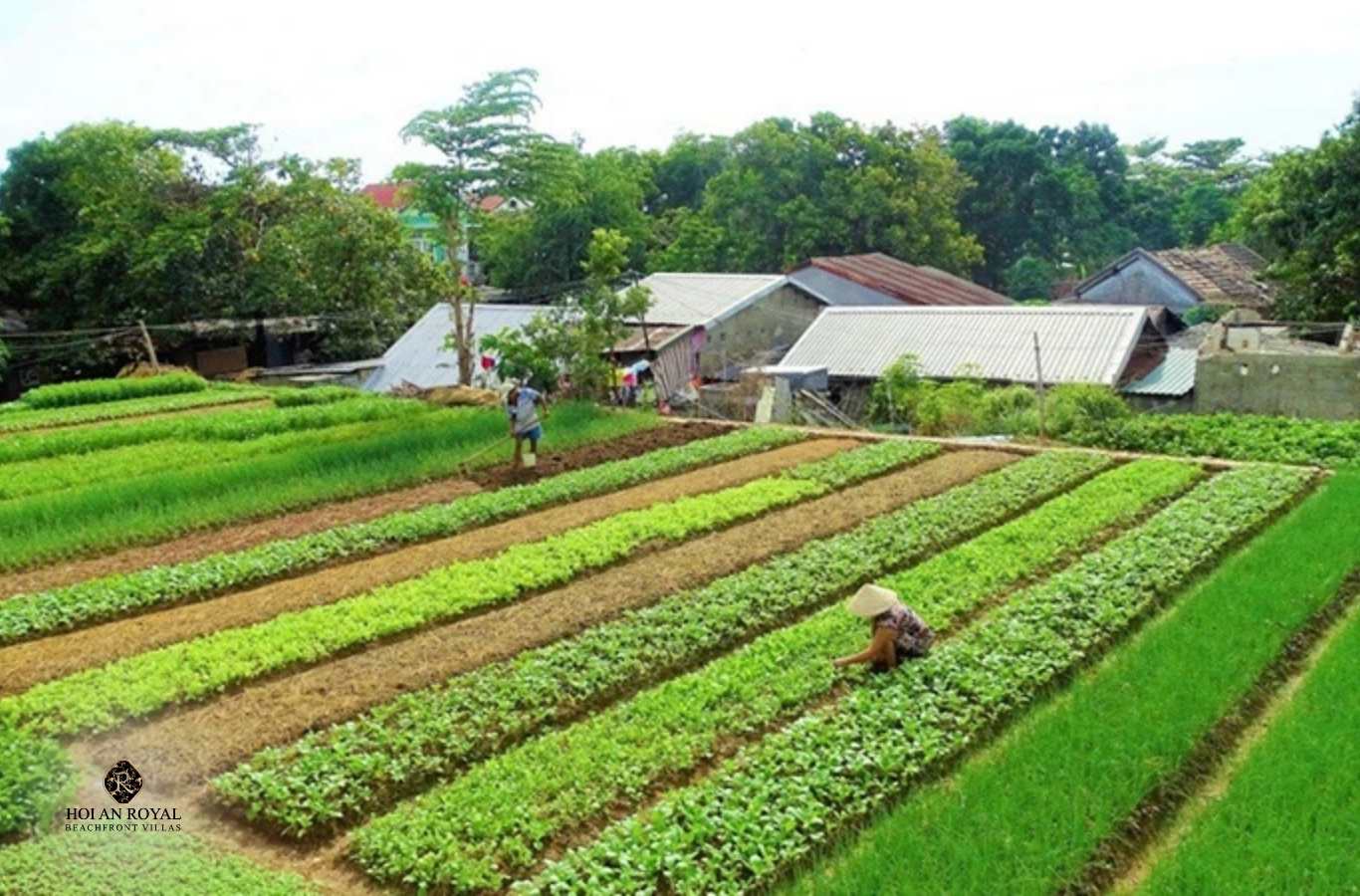
Làng mộc Kim Bồng
Thuộc xã Cẩm Kim, cách trung tâm phố cổ khoảng 3km, làng mộc Kim Bồng là điểm đến gắn liền với một trong những nghề truyền thống lâu đời nhất tại Hội An. Du khách có thể đến đây bằng xe đạp, xe máy hoặc thuyền qua sông Thu Bồn.
Làng nghề hình thành từ thế kỷ XVI, có tuổi đời hơn 500 năm, nổi tiếng với nghề mộc dân dụng, mộc kiến trúc và đóng thuyền. Nơi đây quy tụ nhiều nghệ nhân tài hoa, tạo nên các sản phẩm gỗ tinh xảo mang giá trị nghệ thuật cao.
Không gian làng vẫn giữ được nhiều căn nhà truyền thống và xưởng mộc. Du khách có thể tận mắt chứng kiến quy trình đục, bào, chạm khắc thủ công, cũng như tham gia trải nghiệm chế tác gỗ và tìm hiểu lịch sử làng nghề.
Làng mộc Kim Bồng không thu vé vào cổng, là điểm đến tuyệt vời cho những ai yêu thích văn hóa thủ công truyền thống. Đồng thời, đây còn là lực lượng chủ chốt góp phần trùng tu, gìn giữ di sản kiến trúc phố cổ Hội An.
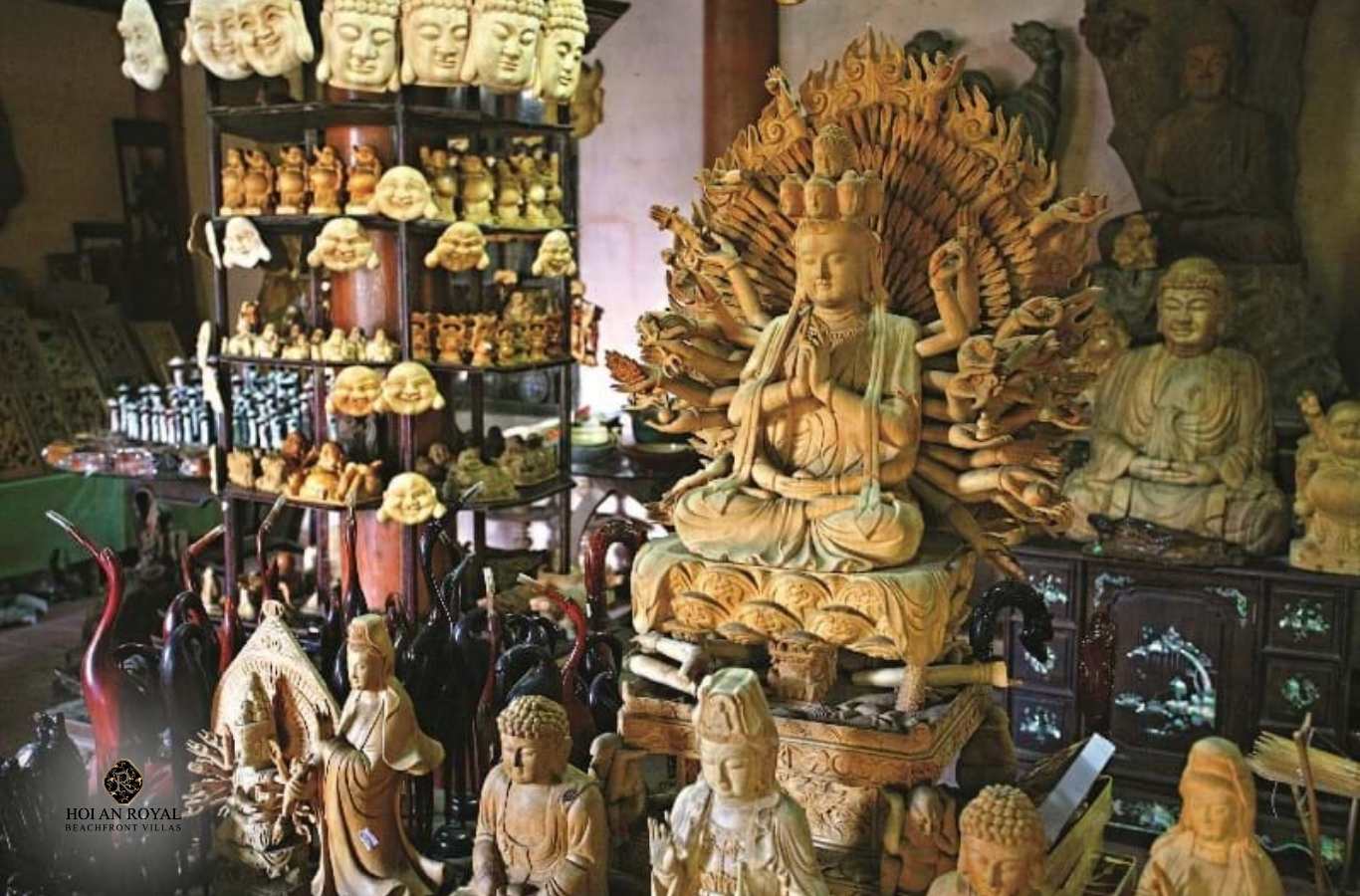
Làng lụa Hội An
Làng Lụa Hội An tọa lạc tại số 28 Nguyễn Tất Thành, chỉ cách phố cổ khoảng 1km, là nơi lưu giữ và phục dựng nghề dệt lụa truyền thống có lịch sử hơn 300 năm, từ thời Chăm Pa đến Đại Việt.
Tại đây, du khách sẽ được trải nghiệm toàn bộ quy trình làm lụa thủ công – từ trồng dâu, nuôi tằm, ươm tơ, kéo sợi đến dệt lụa bằng khung cửi truyền thống. Không gian làng còn có các nhà rường cổ, trong đó có nơi thờ bà chúa Tằm Tang – Đoàn Thị Ngọc, người có công đưa lụa Hội An vang danh quốc tế.
Ngoài tham quan, du khách có thể thử dệt lụa, khám phá văn hóa dệt truyền thống, ngắm bộ sưu tập áo dài của 54 dân tộc Việt Nam và mua lụa tơ tằm chất lượng cao làm quà lưu niệm. Làng còn có nhà hàng, khách sạn và khu trưng bày phục vụ khách du lịch.
Làng Lụa Hội An được ví như “bảo tàng sống” của nghề lụa xứ Quảng, là điểm đến văn hóa hấp dẫn với giá vé tham quan khoảng 50.000 đồng/người và các gói tour buffet đi kèm.
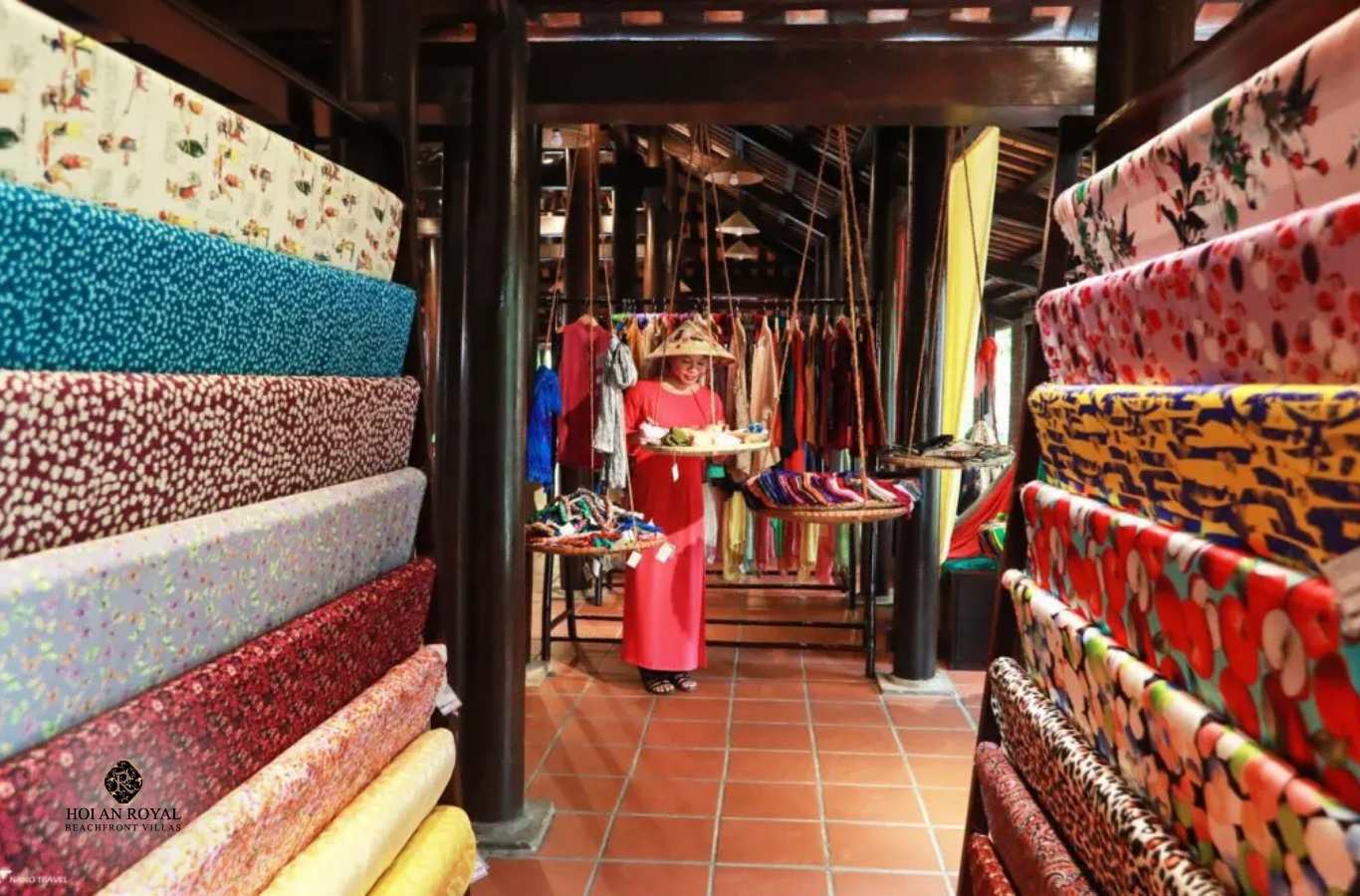
Làng chiếu Bàn Thạch
Làng chiếu Bàn Thạch là làng nghề truyền thống lâu đời, nổi tiếng với nghề dệt chiếu cói thủ công đặc sắc tại Hội An. Đây là nơi gìn giữ nét văn hóa dân gian gắn liền với đời sống sinh hoạt người Việt suốt bao thế hệ.
Những chiếc chiếu ở đây được làm hoàn toàn thủ công từ nguyên liệu cói tự nhiên. Nét nổi bật của sản phẩm là chất lượng bền chắc, họa tiết tinh tế và màu sắc hài hòa, thể hiện sự khéo léo của người thợ dệt truyền thống.
Đến làng, du khách có thể quan sát từng công đoạn dệt chiếu: từ thu hoạch, phơi cói đến xử lý và dệt hoàn thiện. Mỗi khung dệt là một nhịp sống bền bỉ đang lặng lẽ nối dài truyền thống làng nghề.
Chiếu Bàn Thạch không chỉ phục vụ nhu cầu trong nước mà còn được xuất khẩu, góp phần phát triển du lịch văn hóa và giữ gìn bản sắc thủ công của Hội An.
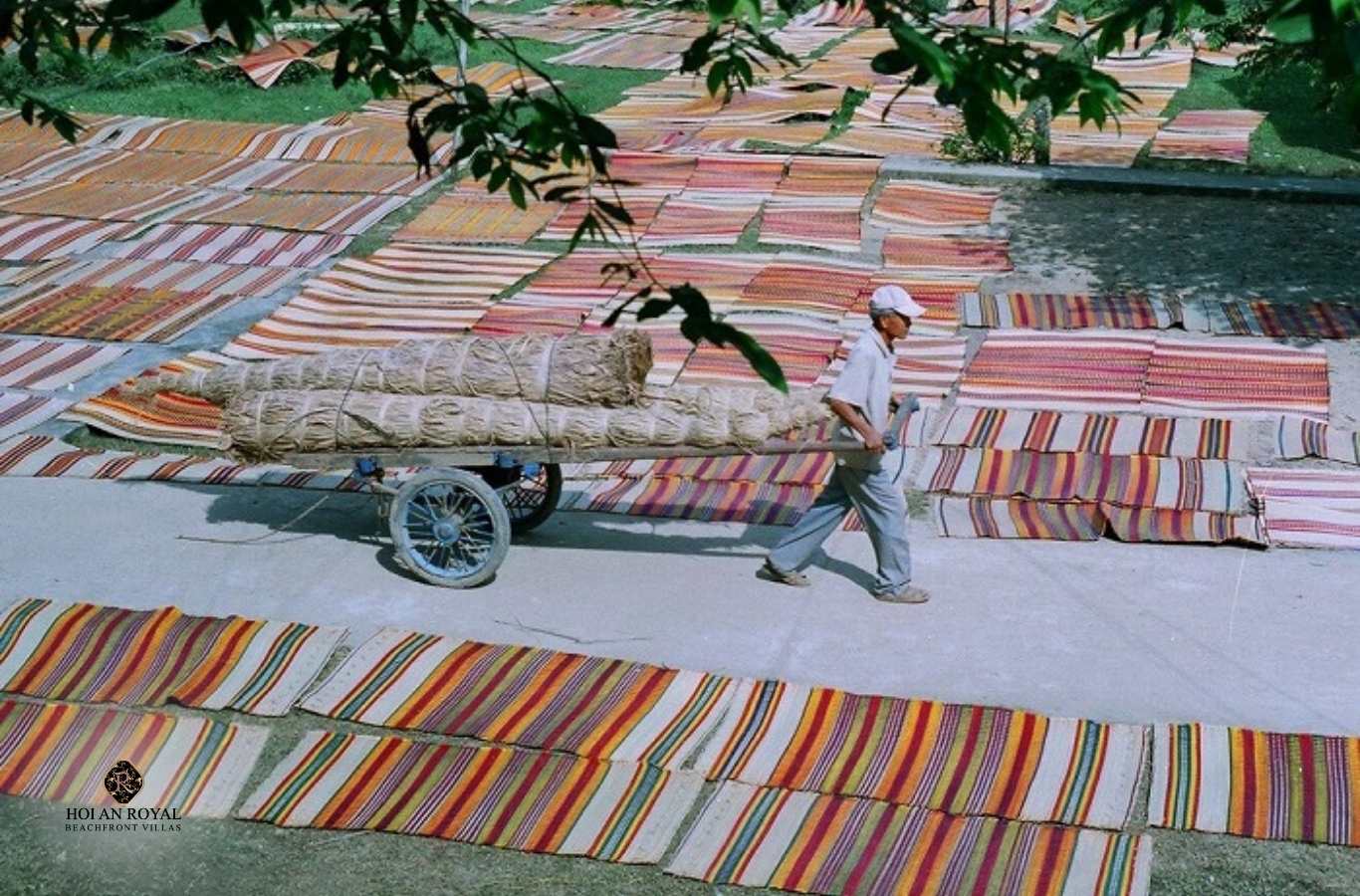
Làng đúc đồng Phước Kiều
Cách phố cổ Hội An khoảng 8km, làng đúc đồng Phước Kiều nằm tại xã Điện Phương (thị xã Điện Bàn), là một làng nghề truyền thống hơn 400 năm tuổi nổi tiếng trên cả nước.
Làng được sáng lập bởi ông Dương Tiền Hiền, gốc Thanh Hóa. Ban đầu chuyên đúc binh khí và đồ dùng cho nhà Nguyễn, sau phát triển thành nơi đúc tượng, chuông, cồng chiêng và các sản phẩm đồng phong thủy, thờ cúng tinh xảo.
Tại đây, du khách có thể tham quan xưởng đúc, xem tận mắt quy trình làm đồng thủ công, chiêm ngưỡng các sản phẩm như chuông đồng, tượng đồng, tranh đồng – tất cả đều mang đậm dấu ấn thủ công và tâm linh truyền thống.
Làng còn nổi tiếng với chiếc Đại Hồng Chung tại nghĩa trang liệt sĩ Điện Bàn – quả chuông lớn nhất từng đúc ở địa phương, nặng 2 tấn với đường kính 1,3m. Nơi đây mở cửa từ 8h – 17h (thứ 2 đến thứ 7), miễn phí tham quan, người dân ở đây rất hiếu khách và rất sẵn lòng chia sẻ về nghề tổ.
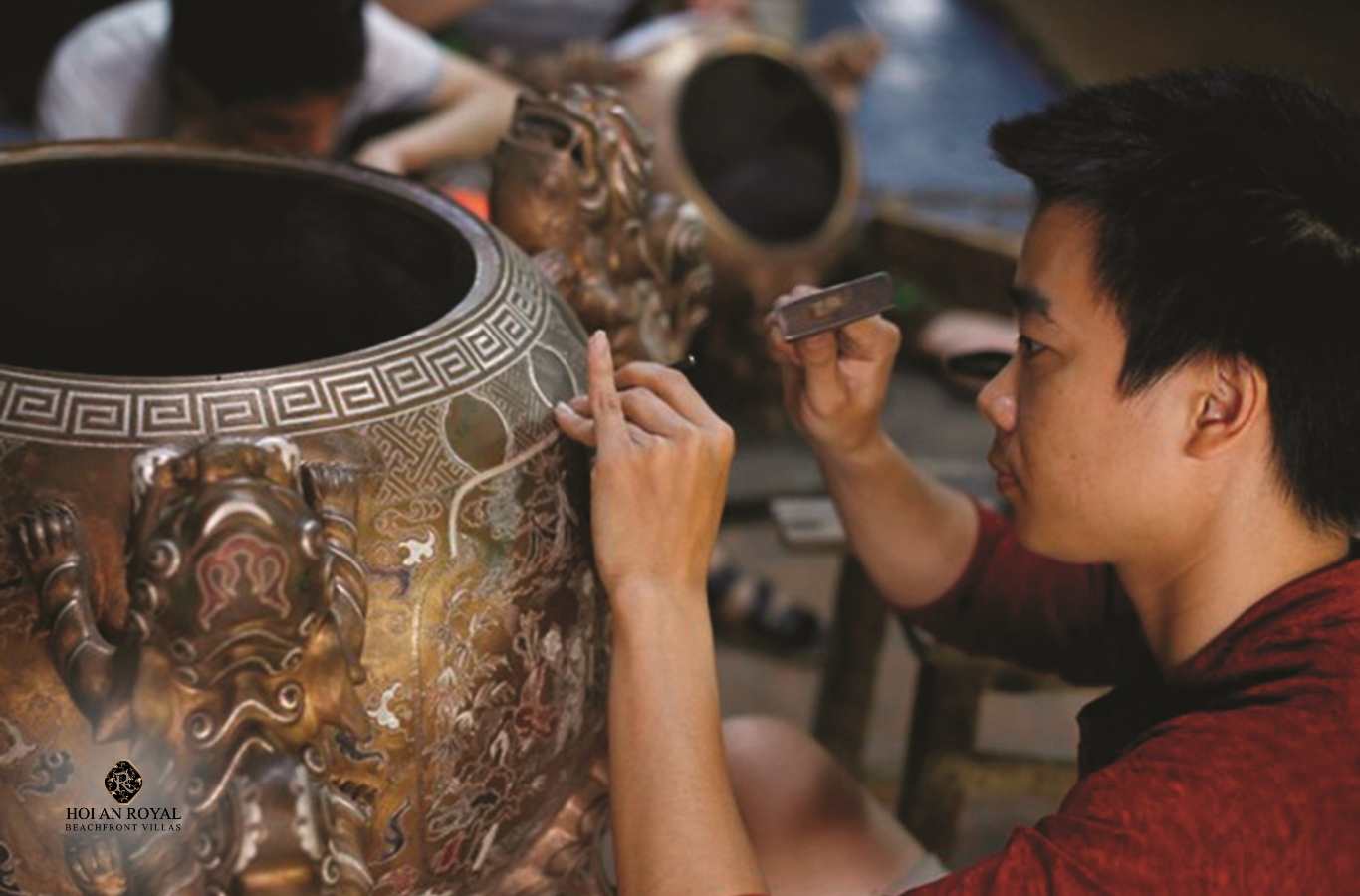
Làng chài Thanh Nam
Làng chài Thanh Nam nằm ven biển Cửa Đại, thuộc thành phố Hội An, tỉnh Quảng Nam. Dù không rộng lớn, nơi đây lại sở hữu vẻ đẹp mộc mạc, gần gũi, thu hút nhiều du khách trong và ngoài nước.
Điểm nhấn đầu tiên là bãi biển thơ mộng với cát trắng mịn, nước xanh trong vắt và không khí trong lành. Cảnh vật thanh bình nơi đây khiến bất cứ ai cũng muốn dừng lại lâu hơn để tận hưởng.
Buổi sáng tại làng là khoảnh khắc nhộn nhịp nhất. Chợ cá ven biển họp sớm, những chiếc thúng, ghe nhỏ tấp nập trở về sau chuyến đánh bắt, tạo nên bức tranh sinh động đầy sức sống. Người dân nơi đây sống giản dị, chan hòa và mến khách. Nụ cười hiền hậu, giọng nói nhẹ nhàng và tinh thần hiếu khách của họ để lại nhiều thiện cảm cho du khách thập phương.
Từ làng chài, bạn có thể dạo bước theo những con đường cát dẫn ra biển, ghé thăm vịnh nhỏ, hoặc tham gia chèo thuyền, câu cá để trải nghiệm cuộc sống ngư dân thực thụ.
Ngoài ra, làng còn là nơi gìn giữ văn hóa địa phương qua các sản phẩm thủ công như đèn lồng, áo dài. Trong giai đoạn 1941–1943, làng từng thuộc tổng Thanh Châu, huyện Hòa Vang, phủ Điện Bàn – một phần trong lịch sử hình thành vùng đất này.
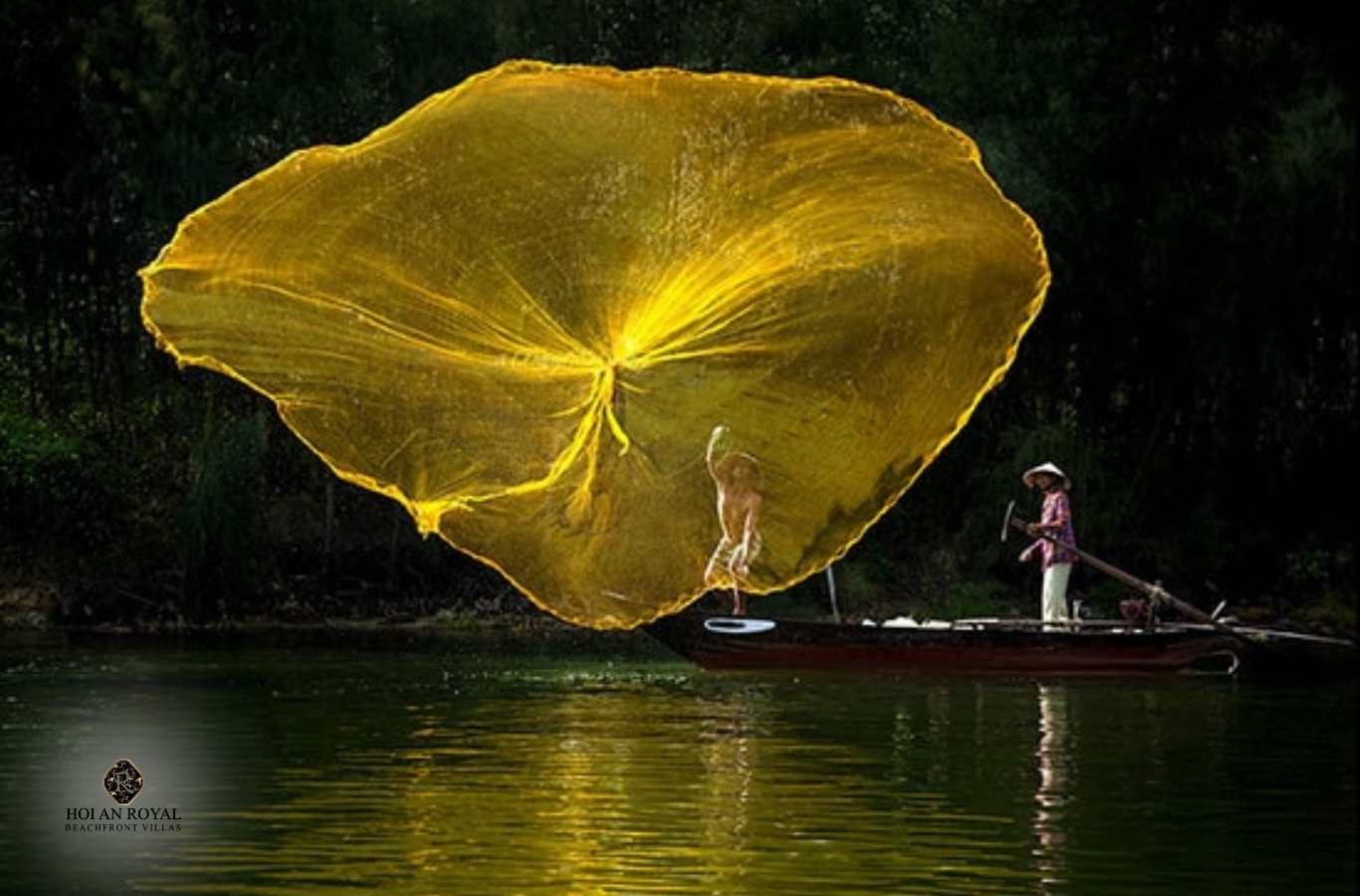
Làng du lịch sinh thái cộng đồng Trà Nhiêu
Tọa lạc tại xã Duy Vinh, huyện Duy Xuyên – cách phố cổ Hội An khoảng 5km, làng Trà Nhiêu là điểm đến lý tưởng để trải nghiệm trọn vẹn vẻ đẹp sông nước, thiên nhiên và làng quê Việt Nam. Nằm ở hợp lưu ba dòng sông lớn – Thu Bồn, Ly Ly và Trường Giang – nơi đây sở hữu không gian trong lành, xanh mát.
Trà Nhiêu nổi bật với cảnh quan làng quê yên bình: đường làng uốn lượn dưới hàng cau, hàng tre rợp bóng, vườn rau xanh ngắt. Du khách đến đây có thể tham gia nhiều hoạt động thú vị như chèo thuyền thúng, đi thuyền sông nước, dệt chiếu, đan lưới, học nấu món dân dã như bánh bèo, bánh đập, mì Quảng…
Bên cạnh đó, làng còn có các chương trình biểu diễn nghệ thuật truyền thống như hát bài chòi, hò khoan đối đáp, bả trạo – mang đậm nét văn hóa dân gian xứ Quảng. Trà Nhiêu cũng là nơi ghi dấu nhiều sự kiện lịch sử với các bà mẹ Việt Nam anh hùng và người con liệt sĩ trong kháng chiến.
Từ năm 2010, Trà Nhiêu phát triển mạnh du lịch sinh thái cộng đồng với các dịch vụ homestay, tour trải nghiệm và ẩm thực truyền thống. Không gian nơi đây mát mẻ, thanh bình, phù hợp cho những ai muốn nghỉ dưỡng kết hợp tìm hiểu văn hóa làng quê miền Trung.
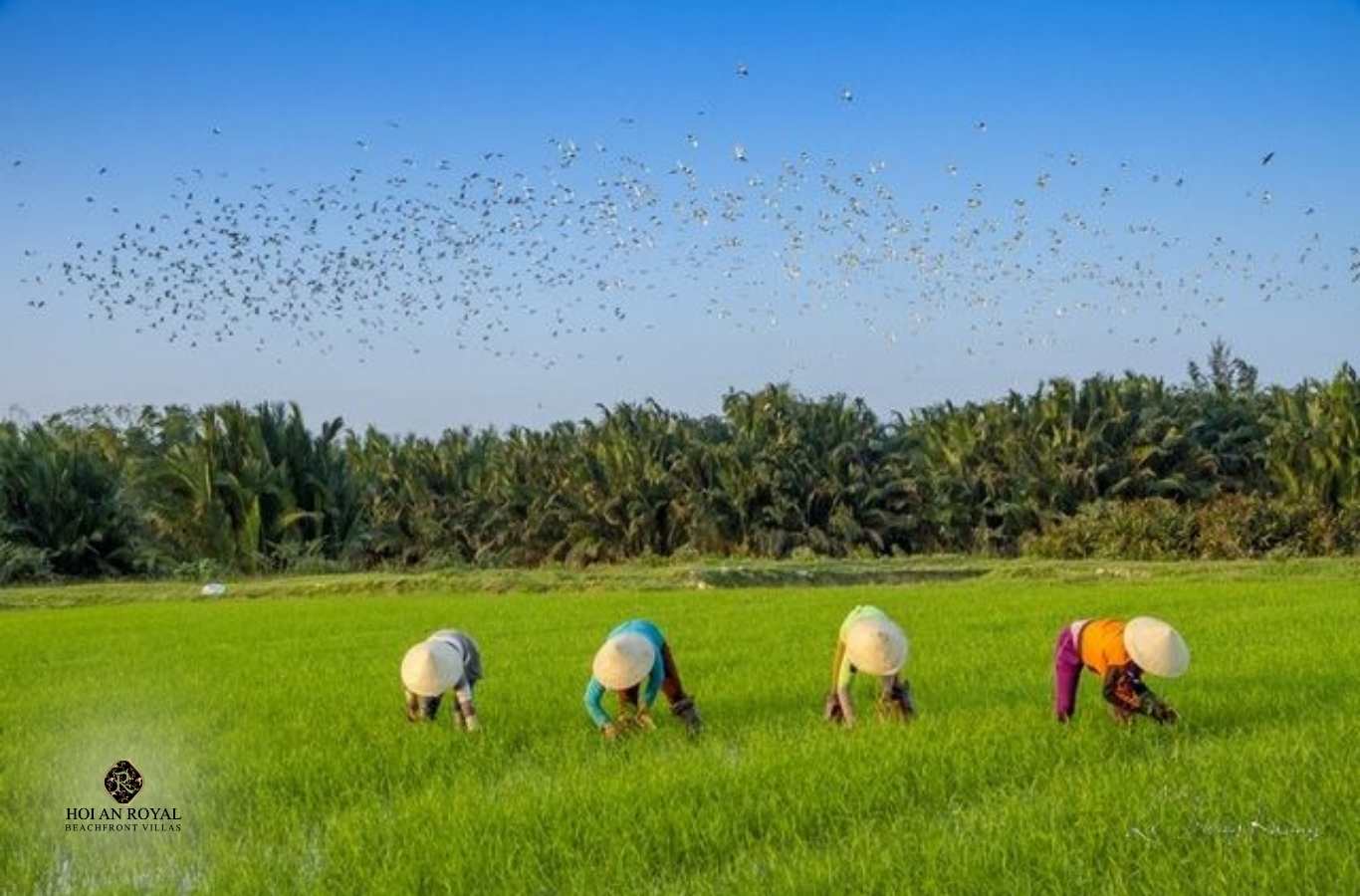
Biển đảo và thiên nhiên hoang sơ
Cù Lao Chàm
Cù Lao Chàm là quần đảo gồm 8 hòn đảo nhỏ thuộc xã Tân Hiệp, cách trung tâm phố cổ Hội An khoảng 15km. Đây là điểm đến lý tưởng cho những ai yêu thiên nhiên biển đảo và muốn trải nghiệm không gian hoang sơ, trong lành.
Du khách có thể đến Cù Lao Chàm bằng cano từ bến Cửa Đại, chỉ mất khoảng 20 phút (giá vé từ 150.000 – 200.000 đồng/người), hoặc đi tàu gỗ từ bến Bạch Đằng với thời gian khoảng 2 tiếng (giá vé từ 50.000 – 80.000 đồng/người).
Nơi đây nổi bật với hệ sinh thái biển phong phú, các rạn san hô nhiều màu sắc và bãi biển xanh ngọc. Một số bãi tắm nổi tiếng như bãi Ông, bãi Chồng, bãi Hương mang đến không gian lý tưởng để nghỉ ngơi, tắm biển và lặn ngắm san hô.
Không chỉ là địa điểm du lịch hấp dẫn, Cù Lao Chàm còn được UNESCO công nhận là khu dự trữ sinh quyển thế giới. Du khách còn có thể trải nghiệm cuộc sống làng chài, câu cá, thưởng thức hải sản và khám phá các giá trị văn hóa truyền thống.
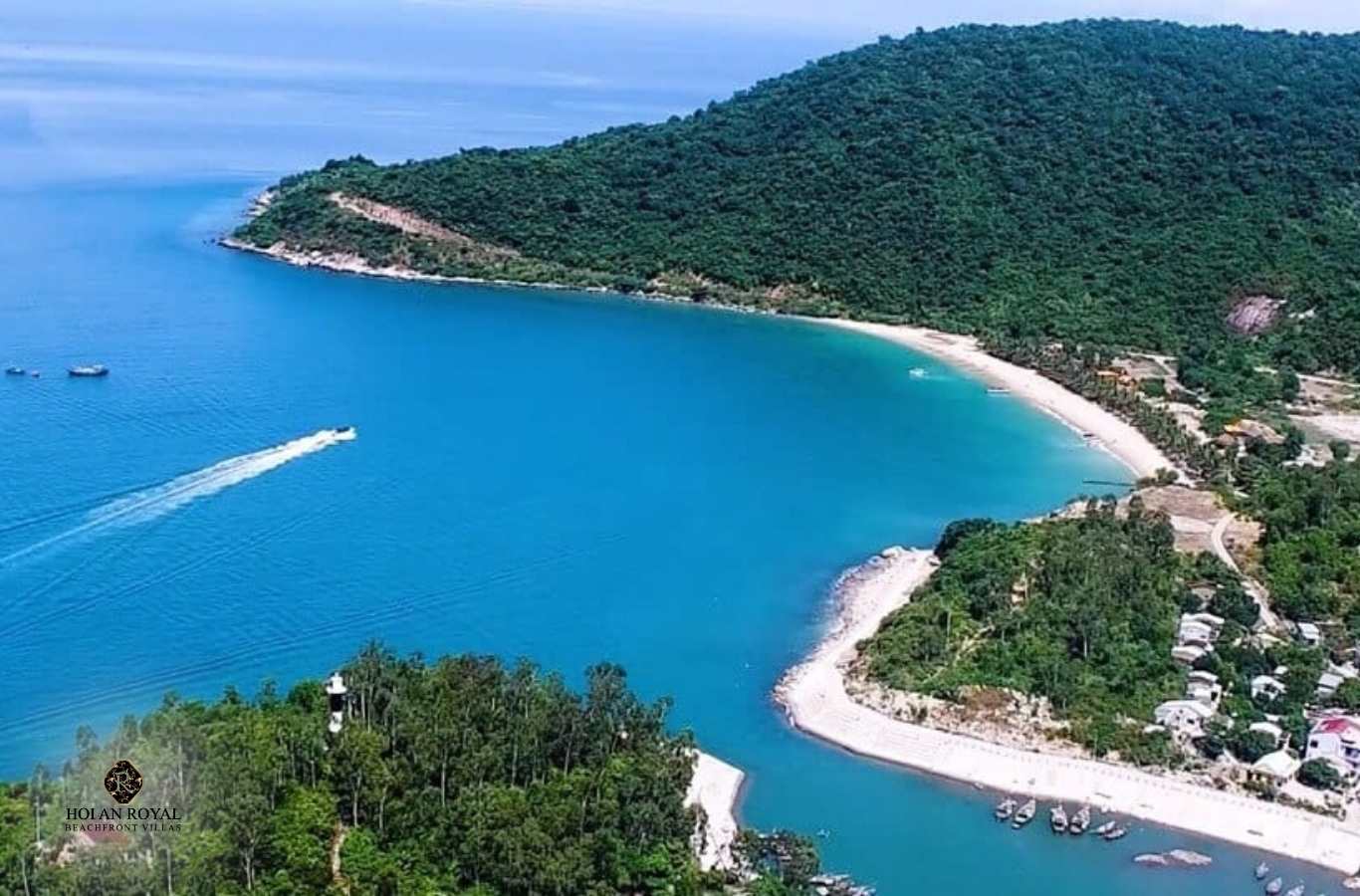
Bãi biển Cửa Đại
Chỉ cách trung tâm phố cổ khoảng 5km, bãi biển Cửa Đại thuộc phường Cẩm An từ lâu đã nổi danh là một trong những bãi biển đẹp nhất châu Á. Bãi cát trắng trải dài, nước biển trong xanh và bầu không khí thoáng đãng là những điểm thu hút của nơi này.
Cửa Đại là nơi hợp lưu của ba con sông lớn: Thu Bồn, Trường Giang và Đế Võng, tạo nên hệ sinh thái và cảnh quan tự nhiên độc đáo. Đây là địa điểm hoàn hảo để ngắm bình minh hoặc hoàng hôn trên biển.
Du khách đến Cửa Đại có thể thư giãn trên ghế lười, tham gia các hoạt động như tắm biển, câu cá, đi thuyền dạo biển, lướt ván, dù bay, mô tô nước hoặc kayak… Mỗi thời điểm trong ngày, màu nước biển thay đổi từ xanh lục sang ngọc bích, mang đến trải nghiệm thị giác thú vị.
Ven biển có nhiều hàng quán, nhà hàng hải sản, quán cà phê và khu nghỉ dưỡng phong phú từ bình dân đến cao cấp, đáp ứng nhu cầu nghỉ dưỡng, ăn uống và thư giãn của mọi du khách.
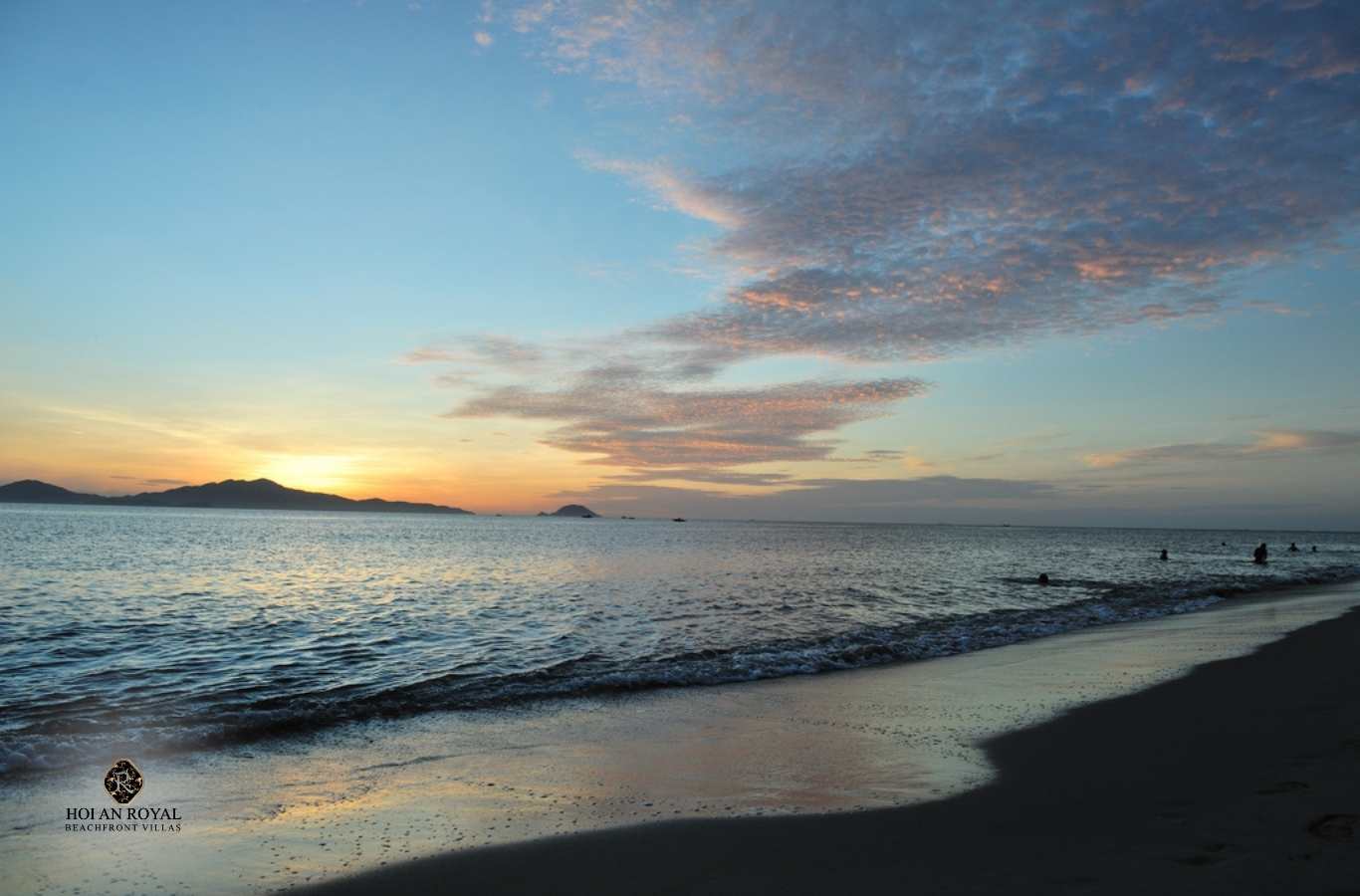
Biển An Bàng
Cách phố cổ Hội An khoảng 3km, bãi biển An Bàng mang vẻ đẹp yên bình và nhẹ nhàng hơn so với Cửa Đại. Bãi cát trắng mịn, làn nước trong xanh và không khí thanh tĩnh tạo nên một không gian lý tưởng để thư giãn.
An Bàng được yêu thích bởi sự nguyên sơ và vắng vẻ, phù hợp với những ai muốn tránh xa ồn ào để tìm sự tĩnh lặng nơi biển cả. Đây là địa điểm tuyệt vời để tắm nắng, bơi lội, lướt sóng nhẹ hoặc đơn giản là nằm dài nghe sóng vỗ.
Bên cạnh đó, bãi biển này còn nổi bật với nhiều quán ăn hải sản tươi ngon, homestay ven biển và quán cà phê phong cách mộc mạc, gần gũi với thiên nhiên. Dịch vụ nơi đây thân thiện, giá cả hợp lý, tạo cảm giác dễ chịu và thoải mái cho du khách.
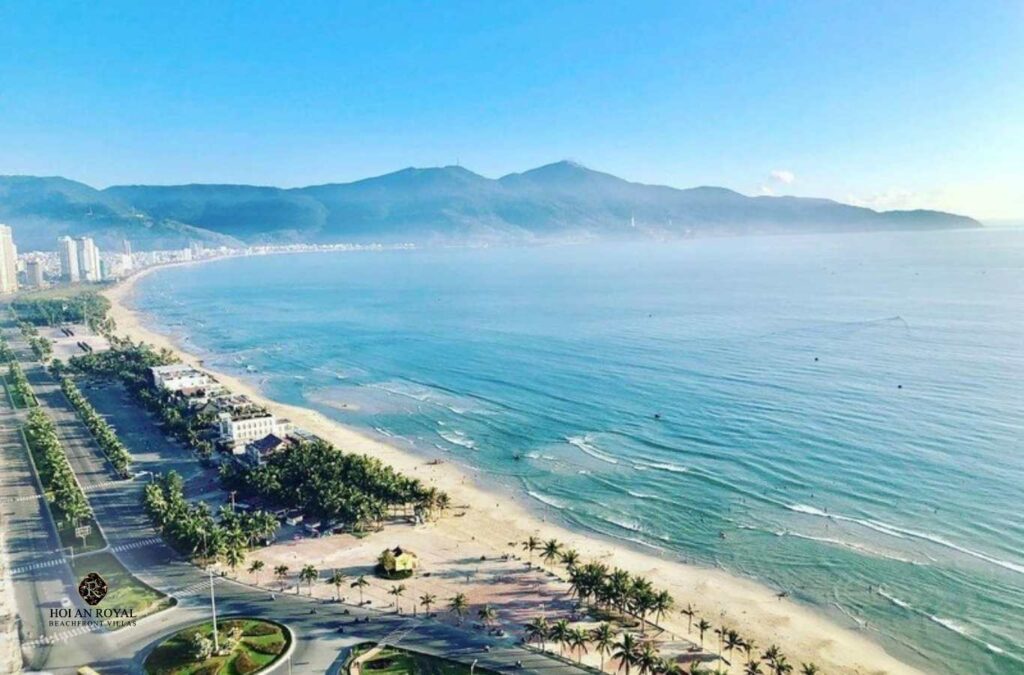
Thánh Địa Mỹ Sơn
Cách trung tâm Hội An khoảng 40km, Thánh địa Mỹ Sơn là quần thể đền tháp cổ của vương quốc Chăm Pa, được xây dựng từ thế kỷ IV dưới thời vua Bhadravarman I và hoàn thiện vào cuối thế kỷ XIII – đầu XIV. Đây từng là trung tâm tôn giáo, văn hóa và tín ngưỡng quan trọng nhất của Chăm Pa cổ đại.
Quần thể gồm hơn 70 công trình đền tháp, hiện còn khoảng 32 công trình, trong đó 20 đền tháp được bảo tồn. Các kiến trúc tại đây mang phong cách Ấn Độ giáo đặc trưng, được xây dựng bằng gạch đỏ với bố cục gồm đế – thân – đỉnh tháp, tất cả đều quay về hướng Đông – hướng mặt trời mọc.
Mỹ Sơn nổi tiếng với kỹ thuật xây gạch độc đáo và chất kết dính bí ẩn đến nay vẫn chưa giải mã được. Các hoa văn chạm khắc tinh xảo, bia ký chữ Phạn cổ tại đây ghi lại những nghi lễ, sự kiện lịch sử và tín ngưỡng linh thiêng của người Chăm xưa.
Được UNESCO công nhận là Di sản Văn hóa Thế giới năm 1999, Mỹ Sơn là điểm đến văn hóa – lịch sử hấp dẫn. Du khách có thể khám phá các cụm tháp A, B, C với công trình nổi bật như tháp A1 – kiệt tác kiến trúc đặc trưng của vương triều Chăm Pa.
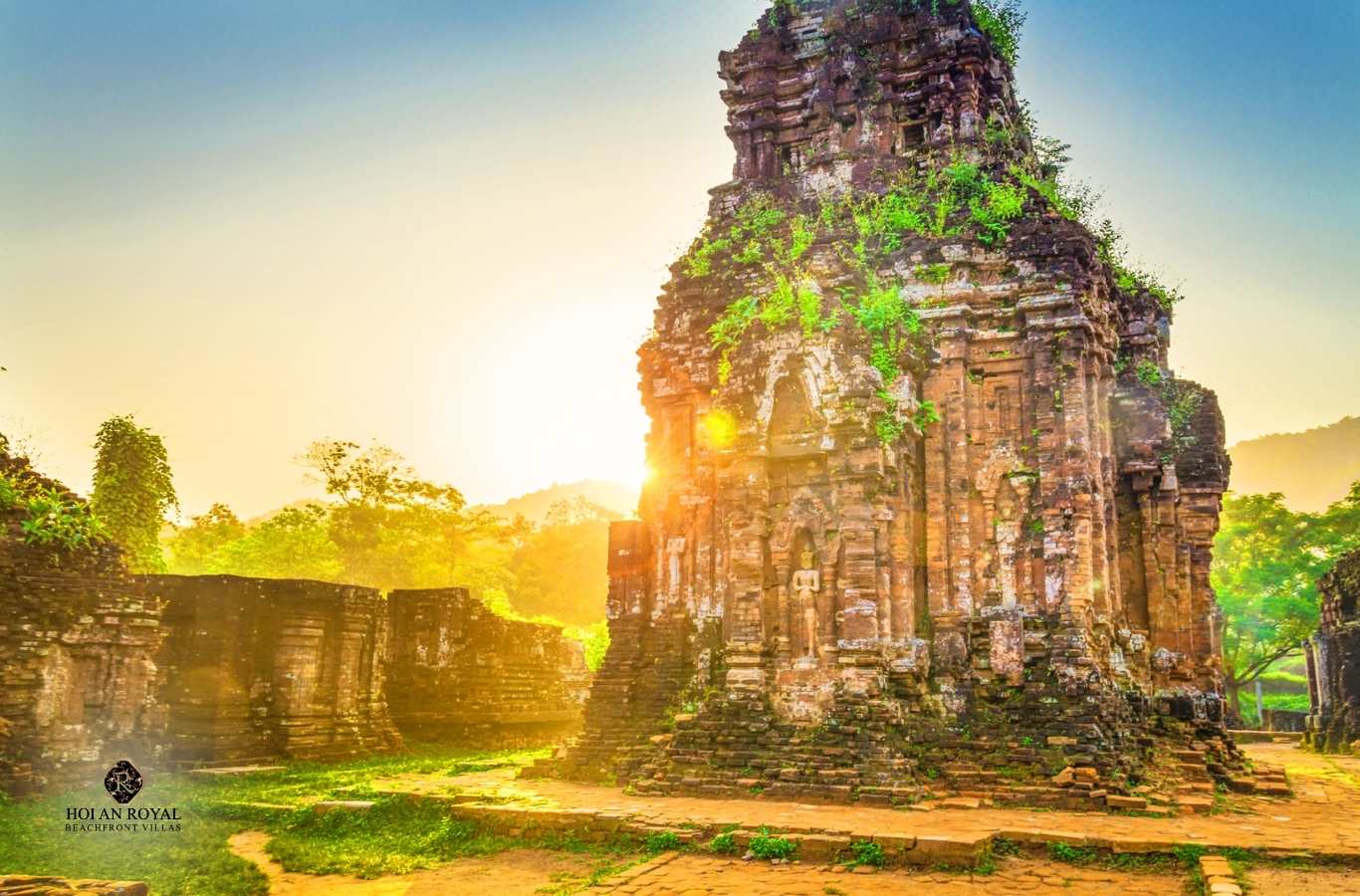
Giếng cổ Chăm
Giếng cổ Chăm là những công trình thủy lợi cổ đại do người Chăm xây dựng, phân bố rải rác trong khu vực Hội An và vùng lân cận. Không chỉ cung cấp nước sinh hoạt, các giếng cổ còn mang ý nghĩa văn hóa – tín ngưỡng sâu sắc với cộng đồng Chăm.
Một trong những giếng nổi bật là Giếng Xó ở phường Cẩm Phô, được bảo tồn và mở cửa đón khách tham quan. Giếng thường gắn với các truyền thuyết dân gian và từng là nơi diễn ra nhiều nghi lễ truyền thống của người bản địa.
Về mặt kiến trúc, giếng Chăm được xây bằng đá hoặc gạch, hình dáng tròn hoặc vuông, đơn giản nhưng kiên cố. Đây là minh chứng cho kỹ thuật xây dựng bền vững và sự gắn bó mật thiết của cư dân xưa với nguồn nước thiên nhiên.
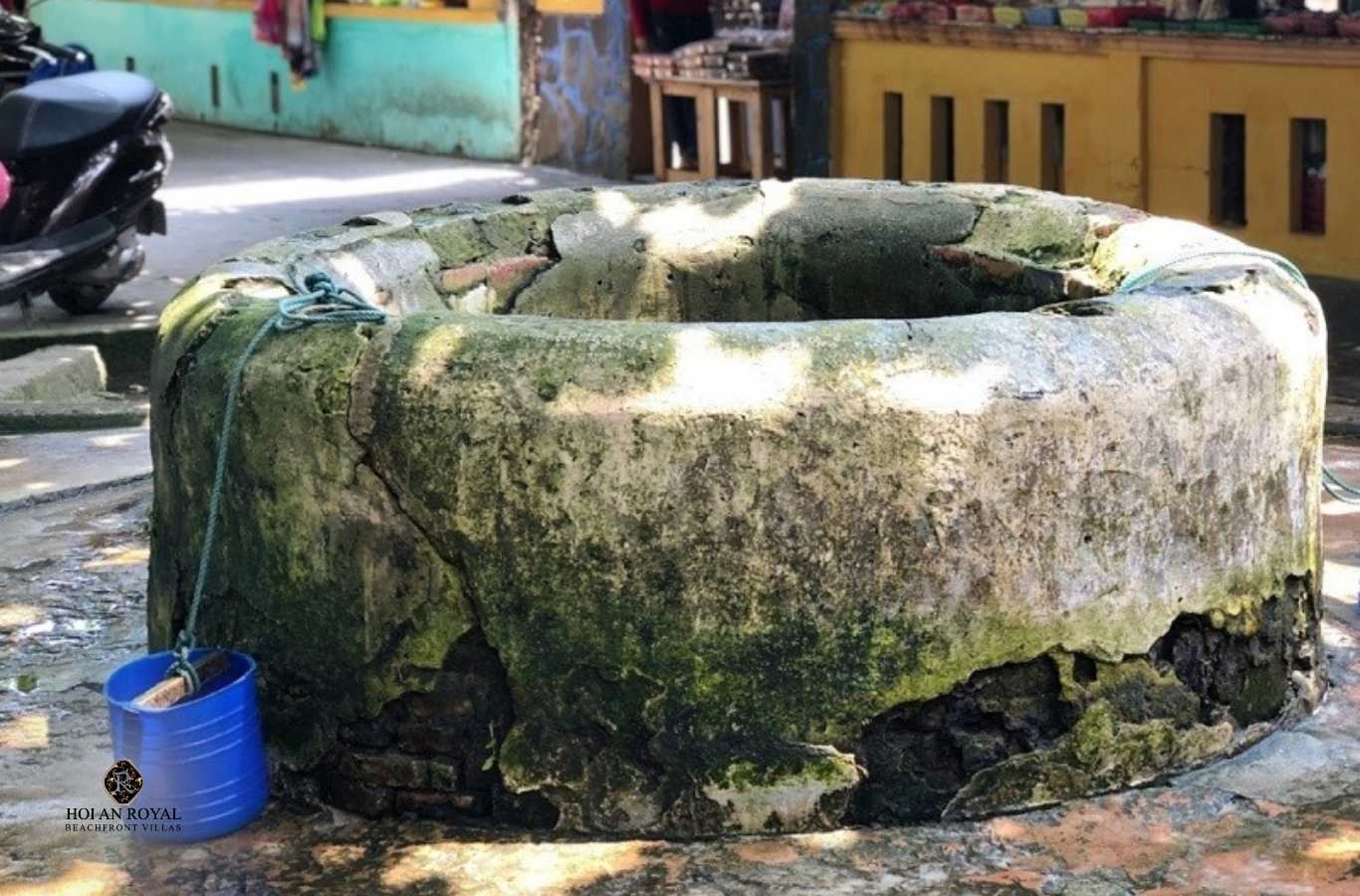
Đảo Yến
Nằm gần Hội An, Đảo Yến là một trong những địa điểm sinh thái hấp dẫn, nổi tiếng với nghề khai thác tổ yến tự nhiên trong các hang đá ven biển. Đây là nơi sinh sống và làm tổ của hàng ngàn cá thể chim yến giữa hệ sinh thái hoang sơ, biển xanh và đá vôi dựng đứng.
Đến đảo, du khách có cơ hội tận mắt quan sát các hang yến, tìm hiểu quy trình khai thác tổ yến từ thiên nhiên và thưởng thức những sản phẩm yến sào chất lượng cao – đặc sản quý hiếm nổi tiếng khắp cả nước.
Không chỉ là nơi gắn liền với sinh kế truyền thống, Đảo Yến còn mang vẻ đẹp hoang sơ tuyệt đẹp với bãi biển sạch, làn nước trong xanh và không khí trong lành. Nơi đây cũng là điểm để trải nghiệm lặn biển, câu cá và nghỉ dưỡng gần gũi thiên nhiên.

Bãi Đá Chồng
Nằm trên đảo Cù Lao Chàm, cách Hội An khoảng 20km, Bãi Đá Chồng là một trong những bãi biển đẹp nhất của quần đảo. Với diện tích khoảng 35.000m², nơi đây nổi bật bởi bãi cát trắng mịn, hàng dừa xanh mát và những khối đá lớn xếp chồng lên nhau theo hình biểu tượng âm dương.
Theo truyền thuyết dân gian, Bãi Chồng mang ý nghĩa tình yêu vĩnh cửu, là nơi lưu giữ vẻ đẹp nguyên sơ và yên bình hiếm có. Khác với nhiều bãi biển du lịch khác, nơi đây vẫn giữ được sự hoang dã tự nhiên, chưa bị khai thác thương mại quá mức.
Du khách có thể tắm biển, dạo bộ trên cát, nằm võng thư giãn dưới bóng dừa hoặc chụp ảnh check-in với khung cảnh thiên nhiên ấn tượng. Đây cũng là nơi để tổ chức các hoạt động team building, cắm trại và dã ngoại.
Bãi Chồng có đầy đủ dịch vụ như nhà tắm, nhà nghỉ tập thể, lều võng, nhà hàng hải sản với các món đặc sản như mực một nắng, cua đá, ốc vú nàng – ngon nhất vào dịp trăng rằm. Để đến đây, du khách đi cano từ cảng Cửa Đại, sau đó tiếp tục bằng xe máy hoặc thuyền nhỏ trên đảo.
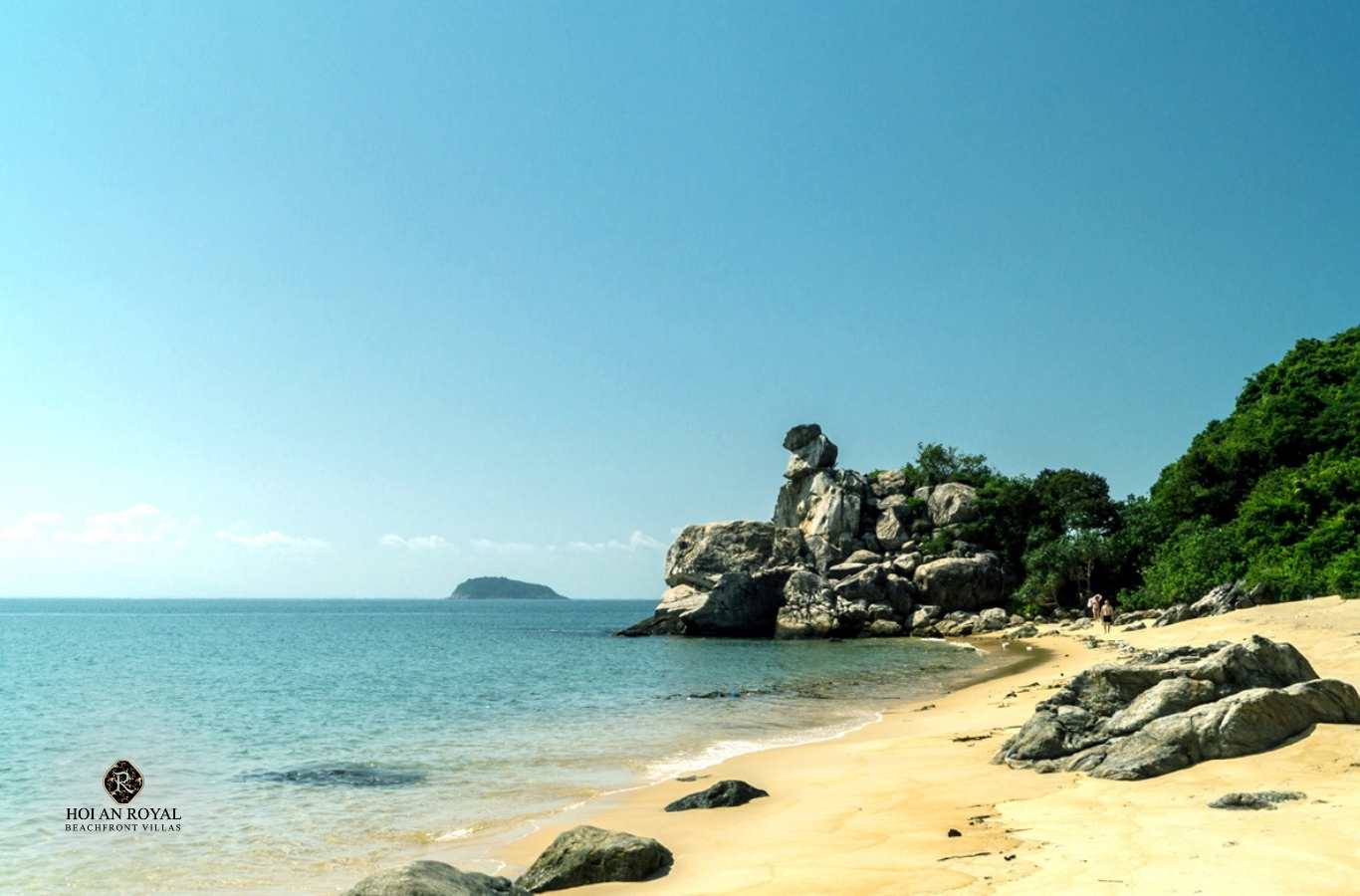
Trải nghiệm văn hóa, giải trí
VinWonders Nam Hội An
Cách trung tâm Hội An khoảng 15km, VinWonders Nam Hội An là khu vui chơi giải trí quy mô lớn thuộc dự án The Center, nằm trên đường Võ Chí Công, xã Bình Minh, huyện Thăng Bình.
Công viên mở cửa từ 9:00 – 18:00 (thứ Hai – Sáu) và đến 19:00 vào cuối tuần. Trên diện tích 50ha, nơi đây chia thành 5 phân khu, kết hợp giữa giải trí hiện đại và trải nghiệm văn hóa truyền thống đặc sắc.
Các phân khu tiêu biểu:
- Bến cảng giao thoa: mô phỏng thương cảng Hội An xưa.
- River Safari: vườn thú trên sông độc đáo.
- Thế giới nước: công viên nước với 11 trò chơi hấp dẫn.
- Đảo văn hóa dân gian: tái hiện không gian văn hóa 3 miền.
- Vùng đất phiêu lưu: các trò chơi cảm giác mạnh trong nhà và ngoài trời.
Ngoài ra, khu vui chơi còn có hệ thống nhà hàng, quầy ẩm thực, khu mua sắm, show biểu diễn nghệ thuật mỗi ngày.
Giá vé khoảng 530.000 đồng/người lớn, ưu đãi cho trẻ em và người cao tuổi. Gói combo kèm buffet dao động từ 760.000 – 850.000 đồng. Đây là điểm đến cho cả gia đình muốn kết hợp nghỉ dưỡng và vui chơi đa dạng trong một không gian tiện nghi, hiện đại.
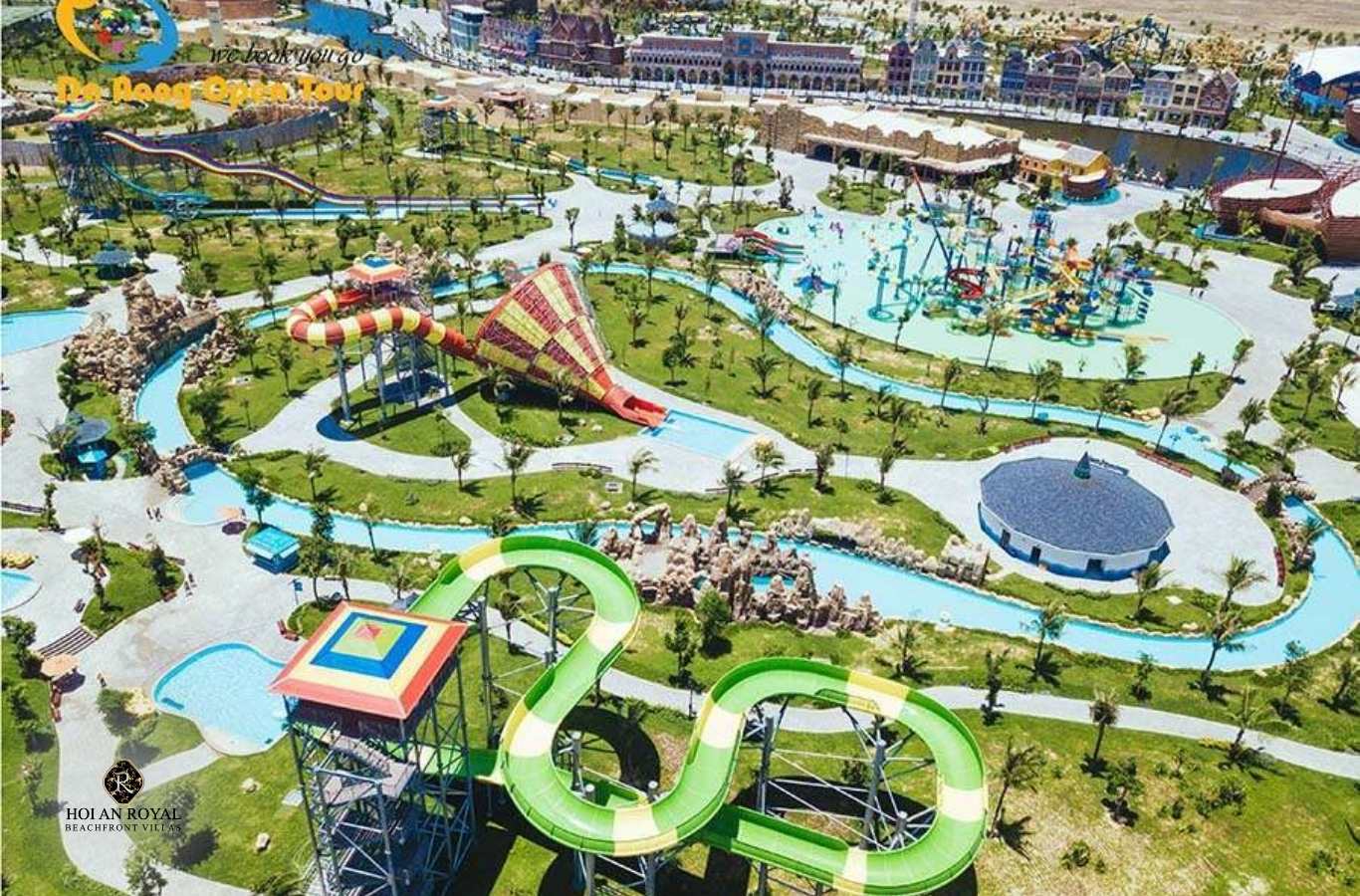
Khu du lịch Cổng trời Đông Giang
Nằm tại xã Ma Cooih, huyện Đông Giang, tỉnh Quảng Nam – cách Hội An khoảng 120km, Cổng trời Đông Giang là khu du lịch sinh thái nổi bật với cảnh quan núi rừng hùng vĩ và khí hậu mát mẻ quanh năm.
Với độ cao hơn 1.400m, nơi đây sở hữu nhiều điểm tham quan ấn tượng như:
- Hai vách núi đá tạo thành “cổng trời” tự nhiên.
- Hang động kỳ ảo như hang Cổng Trời, động Tiên Cung.
- Thác nước Ngọc Vàng, Suối Tiên và các dòng thác nhỏ trong lành.
- Đỉnh núi Rồng Mây, nơi lý tưởng ngắm biển mây bồng bềnh.
Bên cạnh thiên nhiên, du khách còn được tìm hiểu văn hóa người Cơ Tu qua các điệu múa Tungtung Yayá, ẩm thực bản địa và trò chơi dân gian.
Cổng trời Đông Giang còn có cáp treo lên đỉnh Bảo Lâm, cầu kính Ngọc Rồng, công viên Bòn Bon và các dịch vụ tour trọn gói. Giá tour 1 ngày khoảng 1.100.000 đồng, gói 2 ngày 1 đêm từ 1.800.000 đồng/người.
Đây là điểm dừng chân cho những ai muốn hòa mình vào thiên nhiên đại ngàn, kết hợp nghỉ dưỡng, khám phá và học hỏi văn hóa bản địa độc đáo.
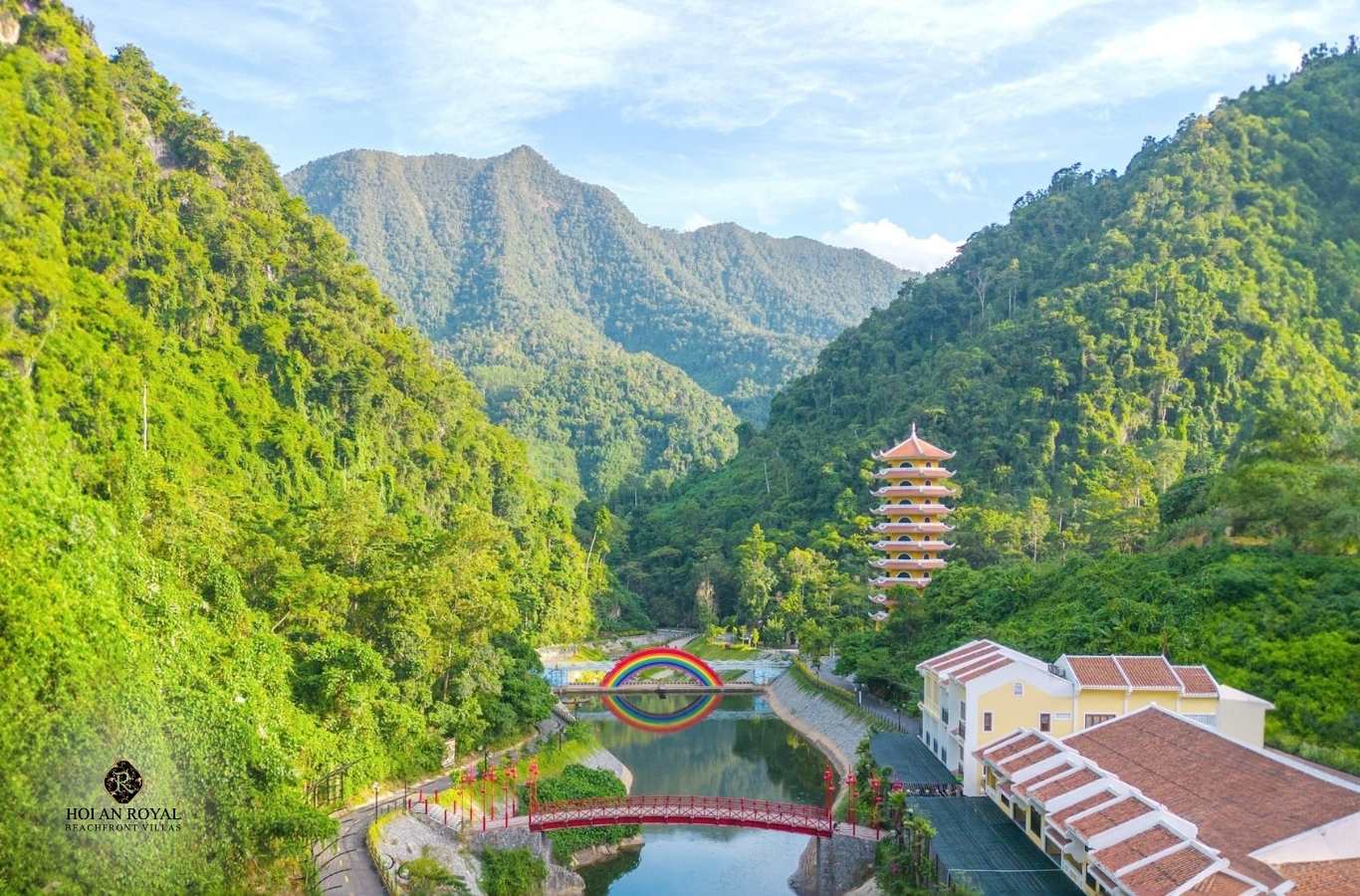
Hòn Kẽm Đá Dừng
Hòn Kẽm Đá Dừng là một hòn đảo nhỏ thuộc vùng biển Quảng Nam, gần Hội An, nổi bật với vẻ đẹp hoang sơ và hệ sinh thái biển đa dạng. Nơi đây là điểm đến yêu thích của những ai đam mê khám phá thiên nhiên nguyên bản.
Bãi biển tại Hòn Kẽm Đá Dừng sở hữu làn nước trong vắt, bờ cát trắng mịn và các rạn san hô rực rỡ. Du khách có thể tham gia các hoạt động như lặn biển, câu cá, ngắm sinh vật biển hoặc tản bộ thư giãn bên bờ cát.
Không chỉ có giá trị sinh thái, đảo còn là nơi sinh sống và làm tổ của nhiều loài chim biển quý hiếm. Không gian yên tĩnh, ít bị khai thác du lịch ồ ạt giúp Hòn Kẽm Đá Dừng giữ được nét mộc mạc, gần như nguyên vẹn.
Du khách thường kết hợp chuyến đi với tham quan các đảo lân cận, khám phá đời sống làng chài và thưởng thức hải sản tươi sống ngay tại bãi biển – một trải nghiệm đậm chất biển miền Trung.
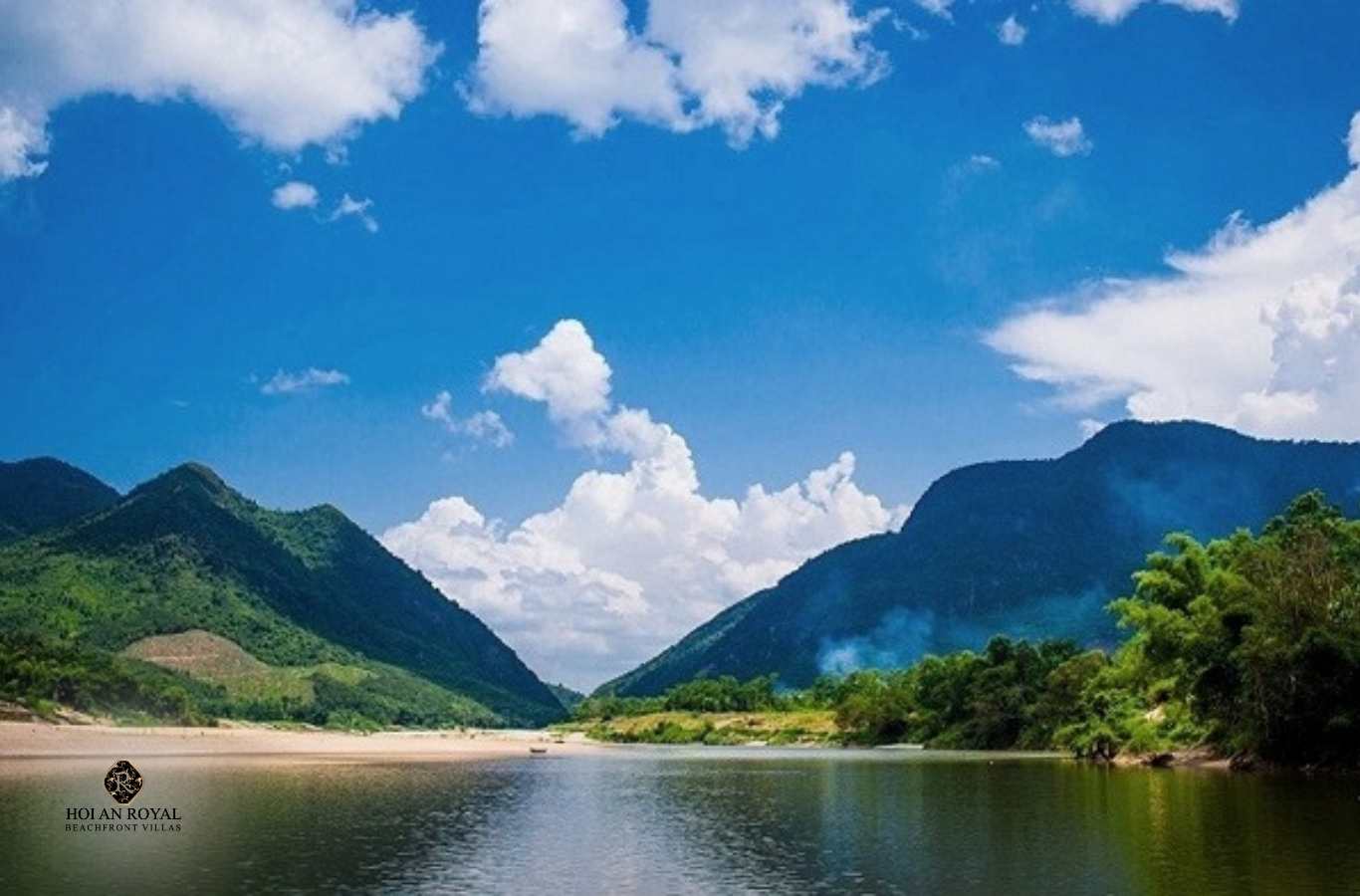
Nên chơi ở đâu tại Hội An vào ban đêm?
Chợ đêm Hội An
Chợ đêm Hội An là điểm đến không thể bỏ qua cho những ai yêu thích nhịp sống sôi động về đêm. Nằm gần khu phố cổ, chợ bắt đầu nhộn nhịp từ chiều tối và kéo dài đến khuya, thu hút đông đảo du khách trong và ngoài nước.
Không gian nơi đây rực rỡ ánh đèn lồng, hòa quyện cùng âm thanh nhạc cụ truyền thống, mùi thơm của các món ăn đường phố và màu sắc của các gian hàng thủ công mỹ nghệ, quà lưu niệm phong phú.
Tại chợ đêm, bạn có thể vừa tản bộ thư giãn, vừa thưởng thức ẩm thực đặc sản, xem biểu diễn nghệ thuật và chọn mua những món đồ đậm chất Hội An. Đây chính là một trong những nơi thể hiện trọn vẹn sự kết hợp giữa văn hóa, ẩm thực và nghệ thuật của thành phố cổ.
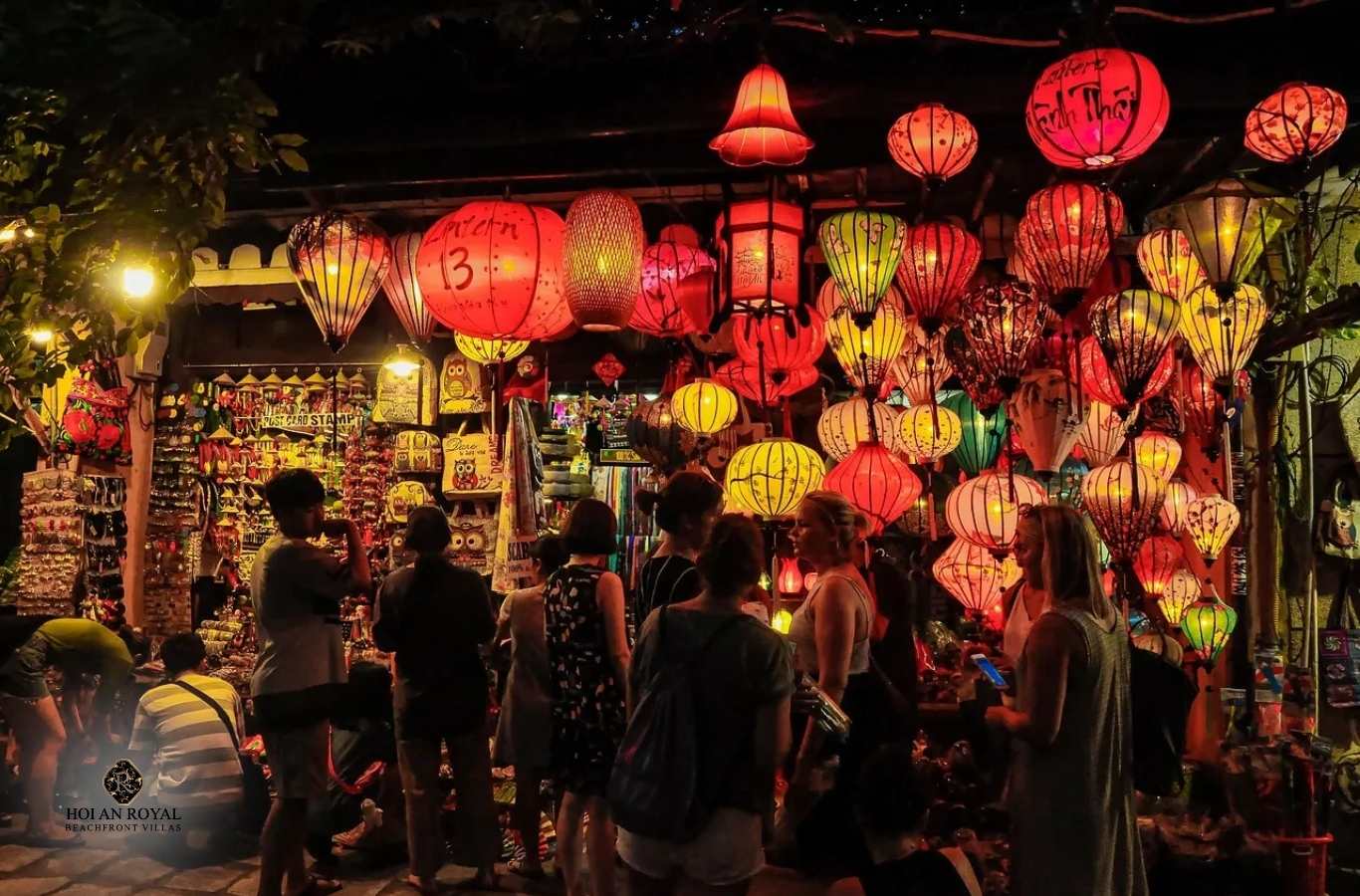
Show diễn Ký ức Hội An
Show diễn Ký ức Hội An là chương trình thực cảnh ngoài trời lớn nhất thế giới được tổ chức tại Việt Nam. Sự kiện diễn ra tại Công viên Ấn Tượng Hội An, trên sân khấu rộng tới 25.000m² với gần 500 diễn viên biểu diễn trực tiếp mỗi tối.
Chương trình gồm 5 màn trình diễn hoành tráng, tái hiện các giai đoạn lịch sử, văn hóa và bản sắc của Hội An qua hơn 400 năm – từ buổi đầu khai hoang đến thời kỳ phát triển rực rỡ như một thương cảng quốc tế.
Điểm đặc sắc của chương trình nằm ở sự kết hợp tinh tế giữa nghệ thuật múa, âm nhạc truyền thống – hiện đại, ánh sáng laser, công nghệ trình chiếu 3D mapping và hiệu ứng âm thanh sống động.
Một số tiết mục nổi bật:
- Sinh Mệnh: khắc họa quá trình khai hoang lập làng.
- Đám Cưới: thể hiện lễ cưới truyền thống rực rỡ.
- Đèn và Biển: câu chuyện tình đầy cảm xúc giữa cô gái phố cổ và chàng trai đi biển, với khung cảnh hoa đăng trên sông Hoài.
Chương trình diễn ra từ 20:00 đến 21:00 hằng ngày (trừ thứ Ba). Giá vé từ 30.000 đến 1.000.000 đồng tùy vị trí. Đây là một trải nghiệm nghệ thuật kết hợp giải trí – giáo dục giàu cảm xúc, giúp du khách hiểu sâu hơn về linh hồn phố Hội.
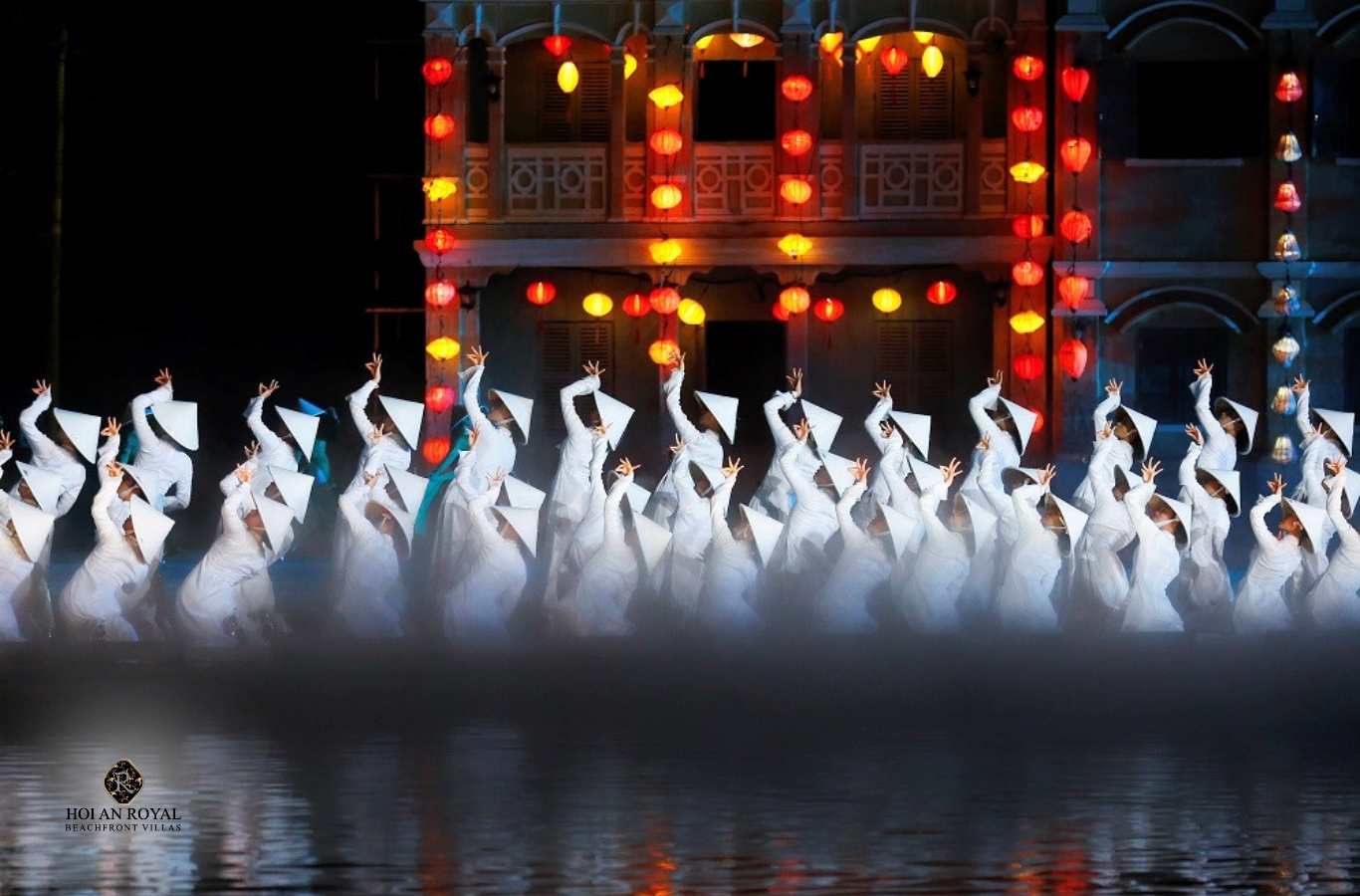
Sông Thu Bồn
Khi màn đêm buông xuống, sông Thu Bồn khoác lên mình vẻ đẹp lãng mạn và trầm lắng, trở thành một trong những điểm đến không thể bỏ lỡ khi khám phá Hội An về đêm. Ánh đèn lồng phản chiếu xuống mặt nước, tạo nên khung cảnh lung linh như cổ tích, thu hút du khách dạo chơi hoặc thả đèn hoa đăng cầu nguyện bình an.
Trải nghiệm đi thuyền trên sông Thu Bồn vào buổi tối là hoạt động được nhiều du khách yêu thích. Ngồi trên con thuyền nhỏ, lướt nhẹ theo dòng nước, bạn có thể ngắm nhìn phố cổ sáng rực đèn, lắng nghe tiếng chèo khua nhè nhẹ và tận hưởng sự bình yên hiếm có. Đây cũng là cơ hội để chiêm ngưỡng hoàng hôn chậm rãi trôi, khi sắc cam hòa quyện với bóng đêm, tạo nên một khoảnh khắc đầy chất thơ.
Dọc theo bờ sông là các hoạt động văn hóa truyền thống như hát bài chòi, giao lưu dân ca, hay những gian hàng nhỏ bán đặc sản địa phương. Sự kết hợp giữa vẻ đẹp thiên nhiên và nét văn hóa dân gian khiến sông Thu Bồn trở thành điểm nhấn độc đáo trong hành trình du lịch Hội An về đêm.
Không chỉ là chứng nhân lịch sử của một thời thương cảng phồn hoa, sông Thu Bồn ngày nay vẫn tiếp tục gìn giữ tinh thần Hội An – trầm lặng, sâu sắc và đầy quyến rũ trong ánh sáng của đêm.
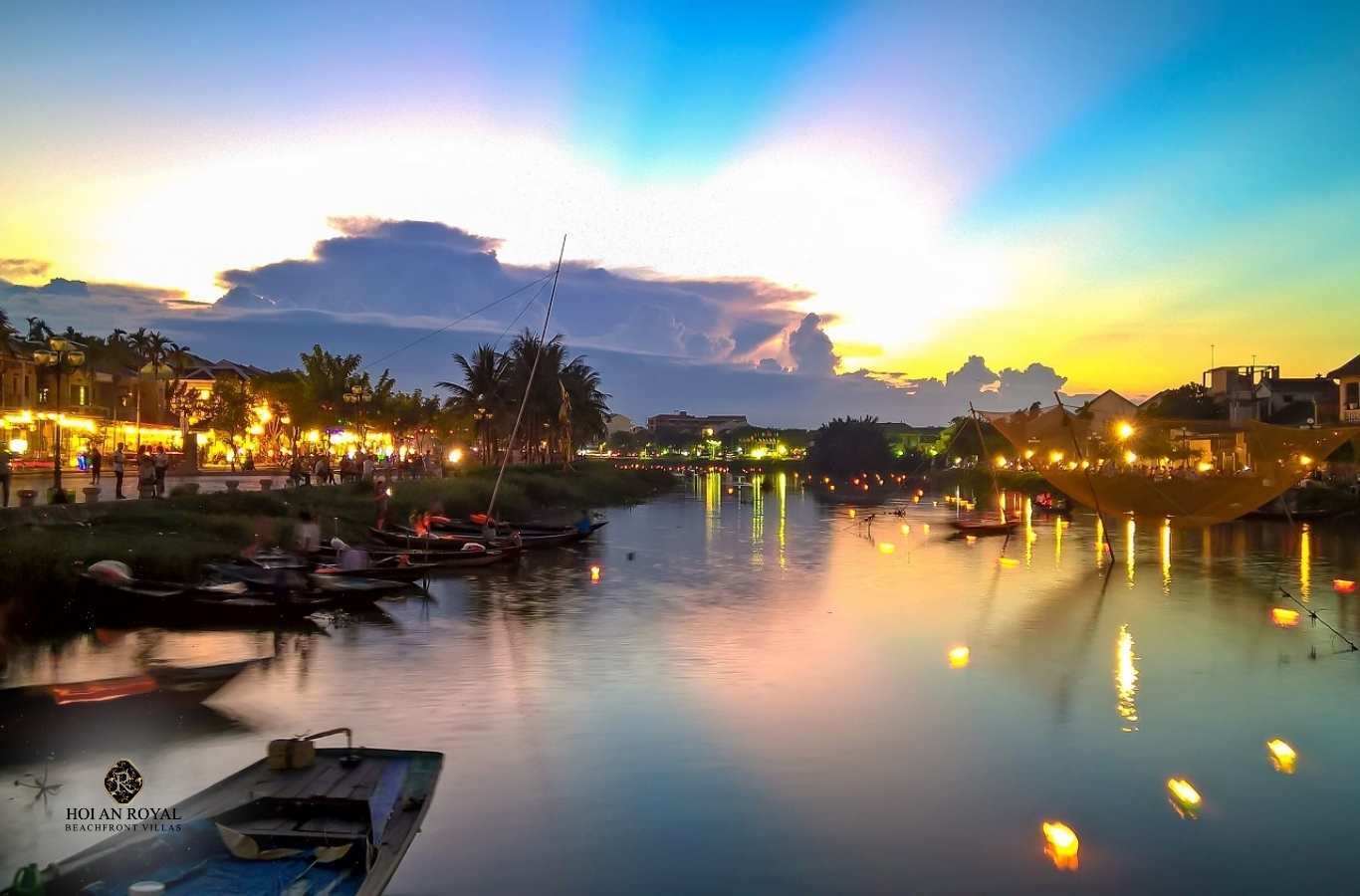
Mẹo di chuyển và chi tiêu khi du lịch Hội An
Khi khám phá Hội An, bạn có thể áp dụng những mẹo sau để thuận tiện di chuyển và tiết kiệm chi tiêu:
- Di chuyển đến Hội An: Bạn có thể lựa chọn máy bay đến sân bay Đà Nẵng rồi tiếp tục đi taxi, xe buýt hoặc xe công nghệ đến Hội An. Ngoài ra, xe khách, tàu hỏa hoặc phương tiện cá nhân cũng là những lựa chọn phù hợp tùy theo nhu cầu và thời gian của bạn.
- Tiết kiệm chi phí: Nên thuê xe đạp hoặc xe máy tại các điểm uy tín, ăn uống ở các quán bình dân hoặc chợ đêm để thưởng thức ẩm thực đặc trưng với giá hợp lý. Khi mua sắm, bạn có thể trả giá nhẹ nhàng để có mức giá tốt hơn. Đặt vé tham quan hoặc dịch vụ trước qua các kênh online cũng giúp bạn tiết kiệm chi phí và tránh phải xếp hàng.
- Tiết kiệm chi phí: Nên thuê xe đạp hoặc xe máy tại các điểm uy tín, ăn uống ở các quán bình dân hoặc chợ đêm để thưởng thức ẩm thực đặc trưng với giá hợp lý. Khi mua sắm, bạn có thể trả giá nhẹ nhàng để có mức giá tốt hơn. Đặt vé tham quan hoặc dịch vụ trước qua các kênh online cũng giúp bạn tiết kiệm chi phí và tránh phải xếp hàng.
- Trải nghiệm thêm: Đi bộ quanh phố cổ cũng là cách tuyệt vời để khám phá Hội An mà không tốn kém. Ngoài ra, bạn có thể thử đi thuyền trên sông Hoài để có góc nhìn khác về thành phố.
Tóm lại, Hội An rất thân thiện với du khách tự túc, bạn chỉ cần lựa chọn phương tiện phù hợp với sở thích và ngân sách, đồng thời lên kế hoạch hợp lý để tận hưởng trọn vẹn chuyến đi mà vẫn tiết kiệm.
Mỗi địa điểm du lịch Hội An đều kể một câu chuyện – từ dòng sông Hoài êm đềm đến những ngôi nhà cổ trầm mặc. Hoi An Royal Beachfront Villas hy vọng bạn sẽ tìm thấy những khoảnh khắc đáng nhớ trong chuyến đi sắp tới, và đừng quên chia sẻ trải nghiệm với những người cùng yêu mến Hội An như bạn.
